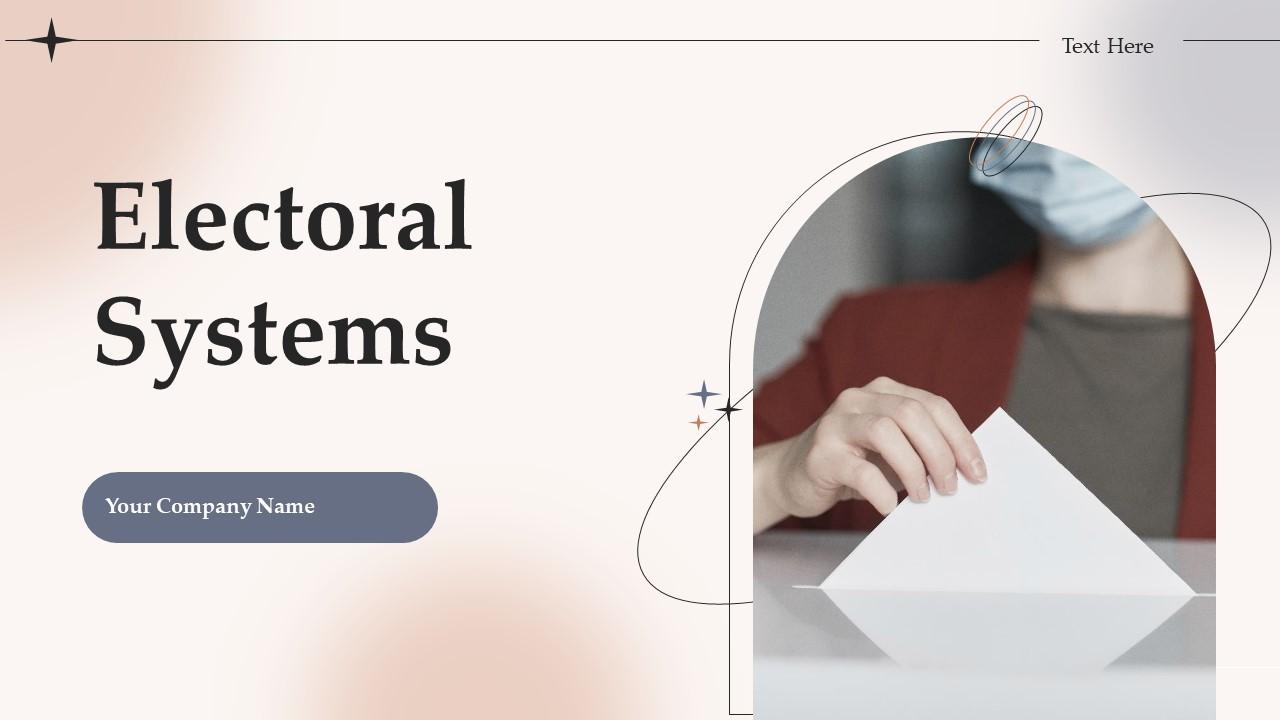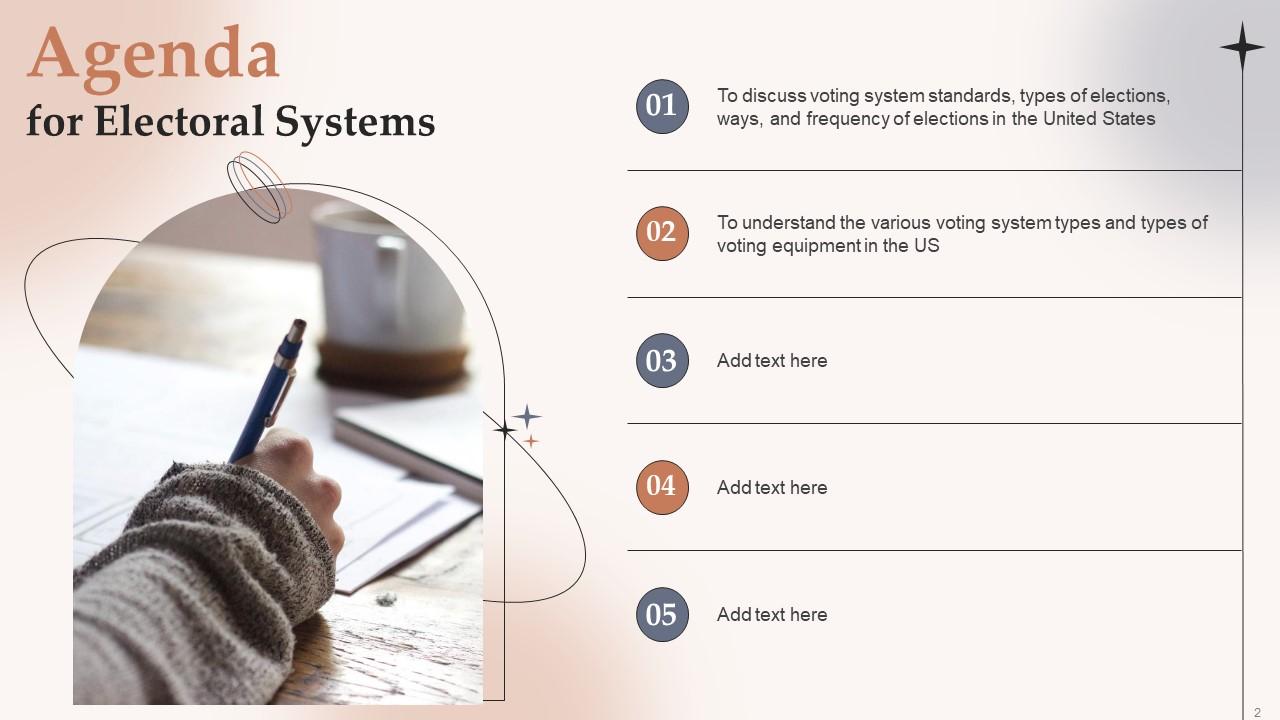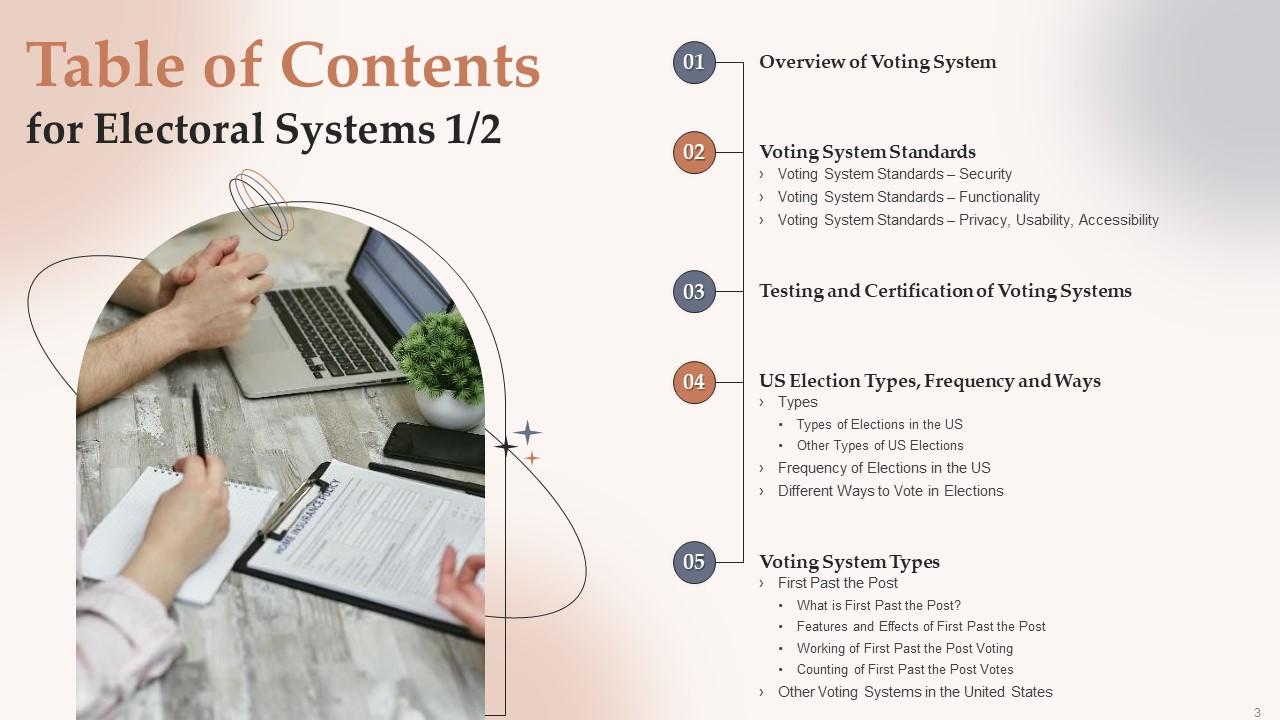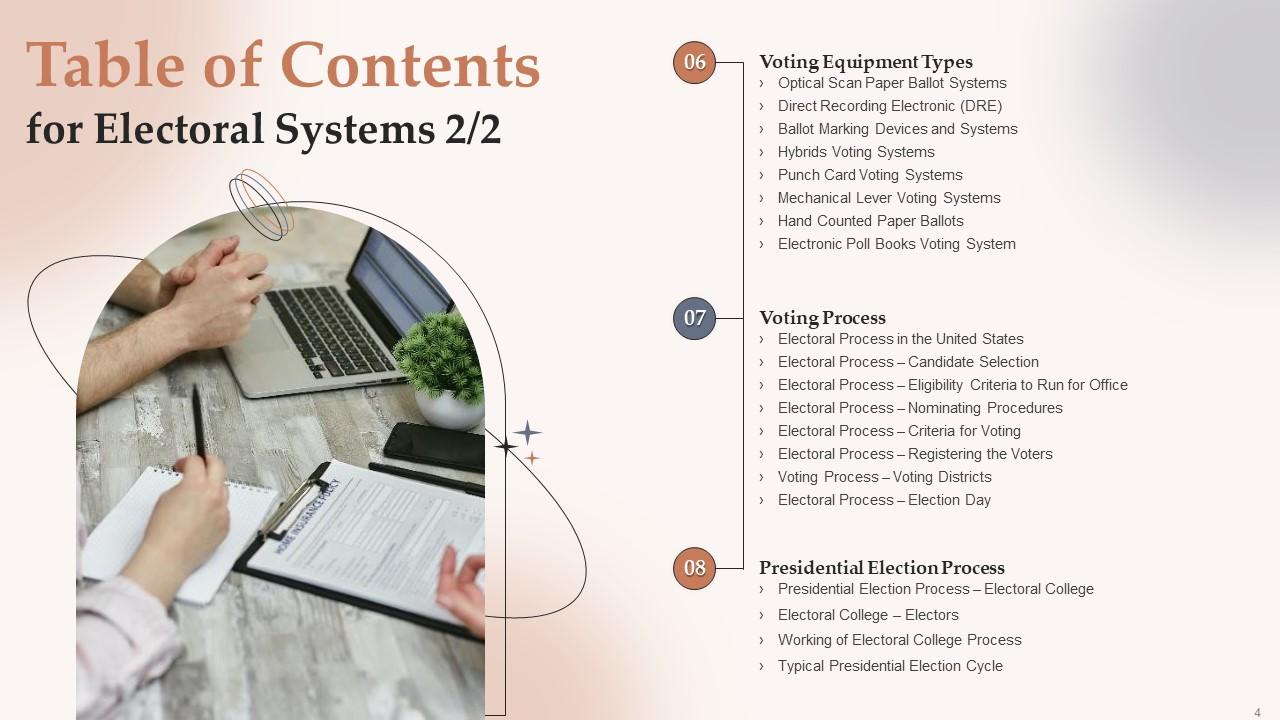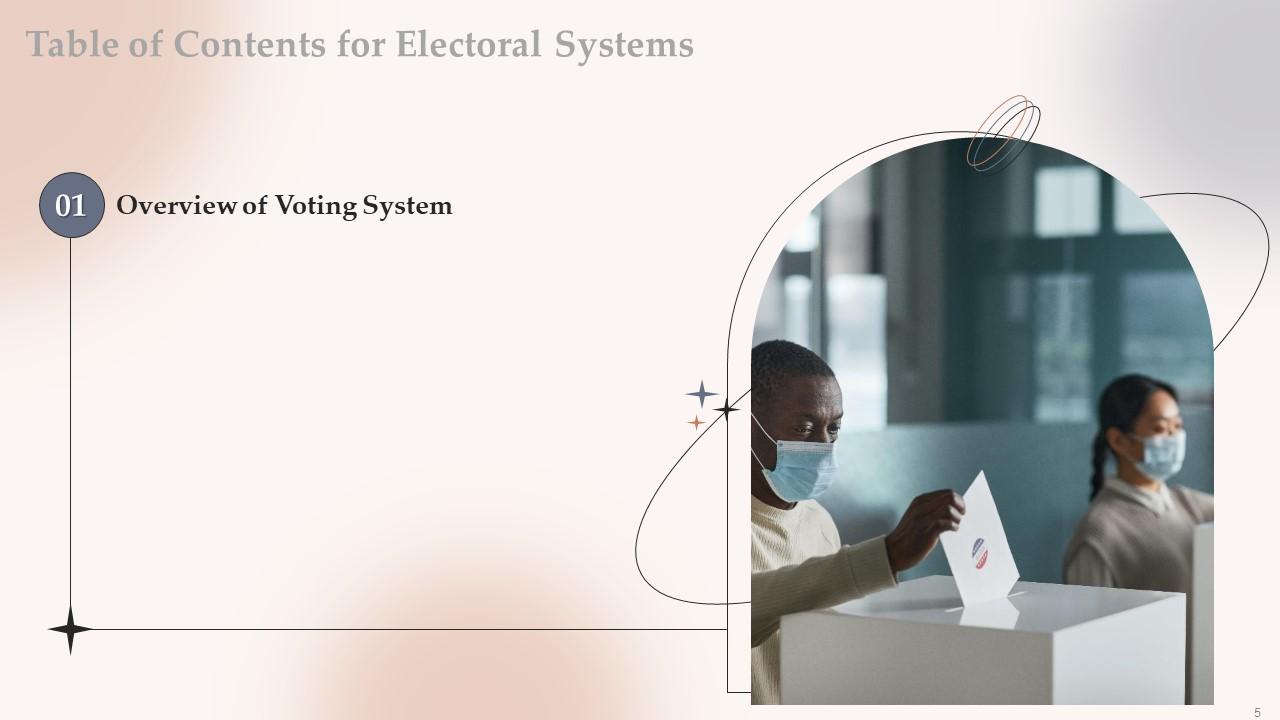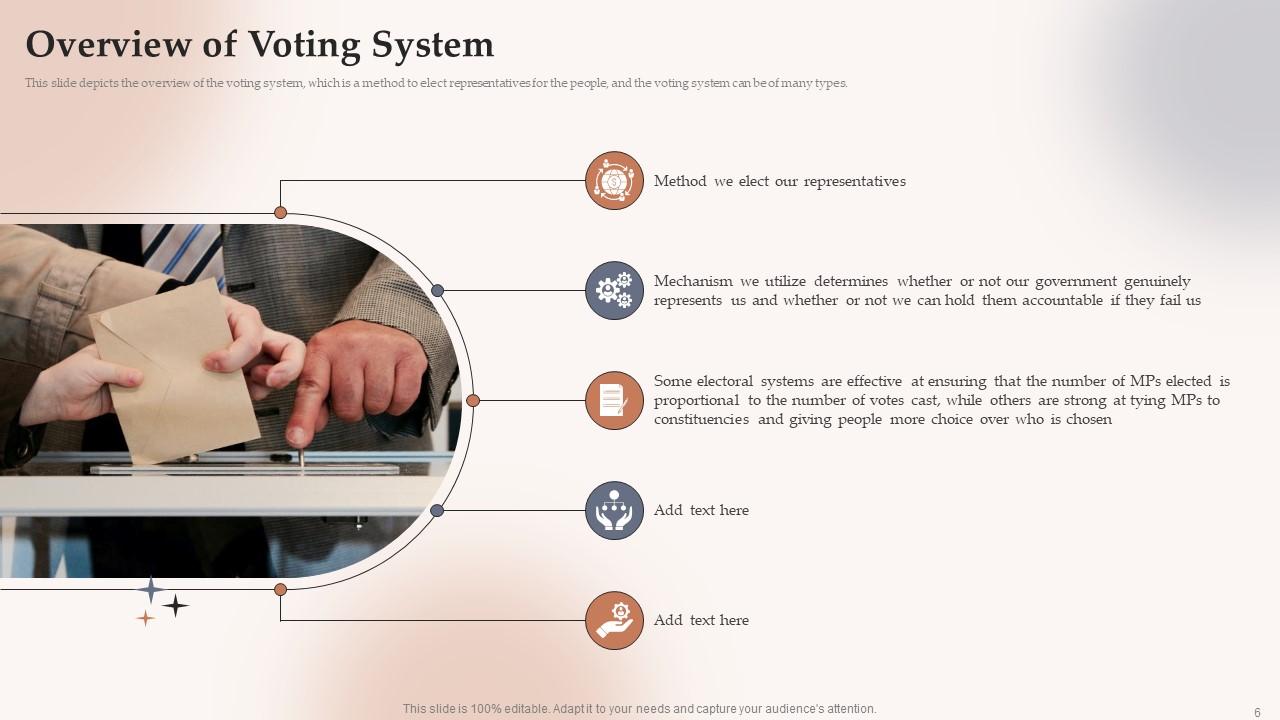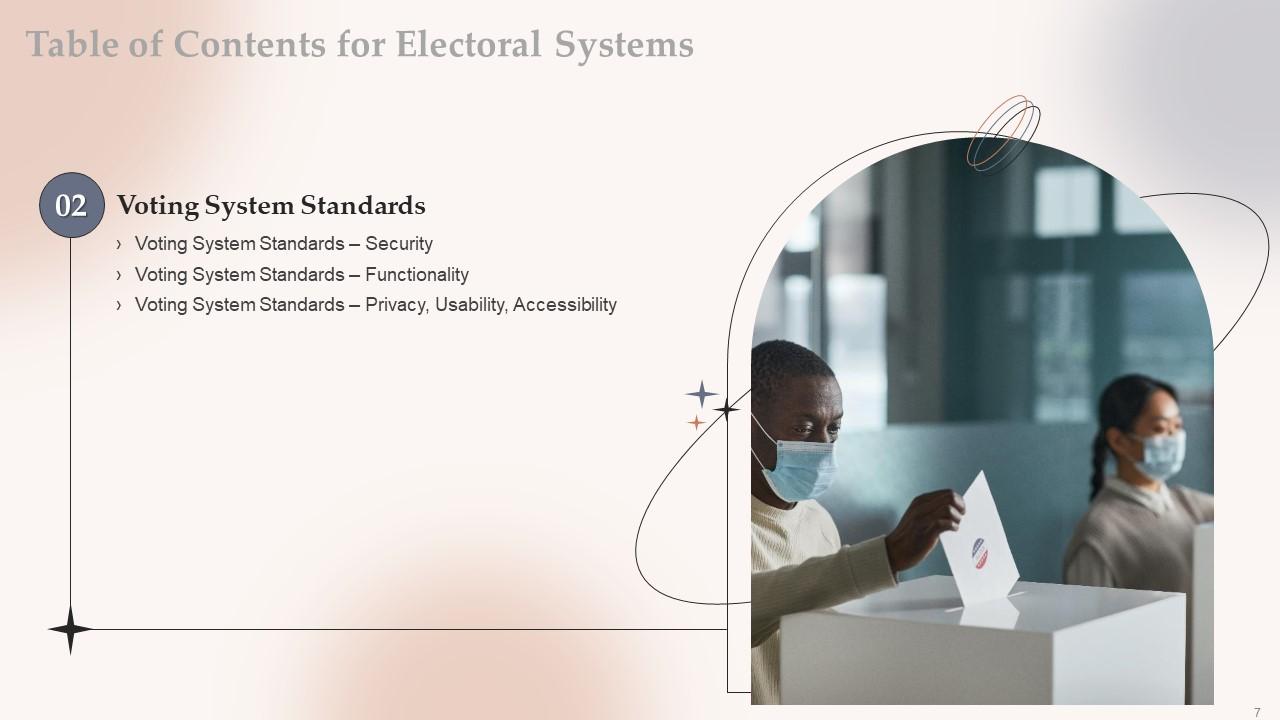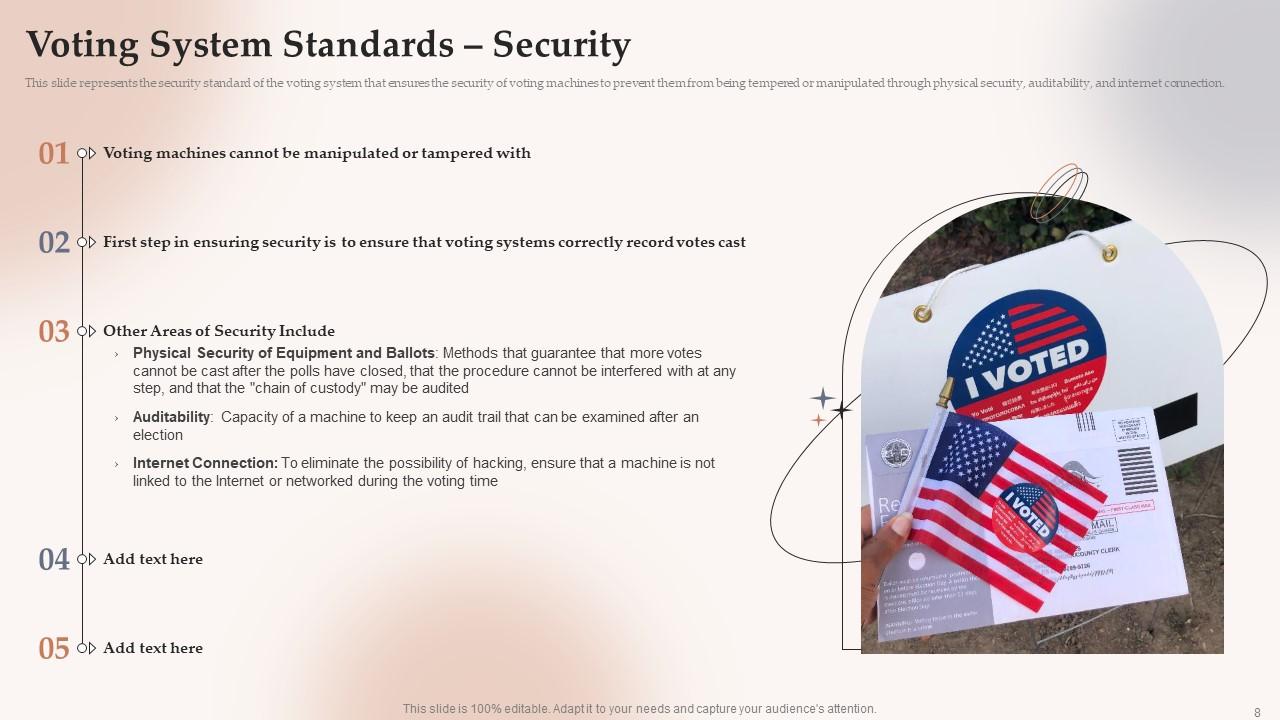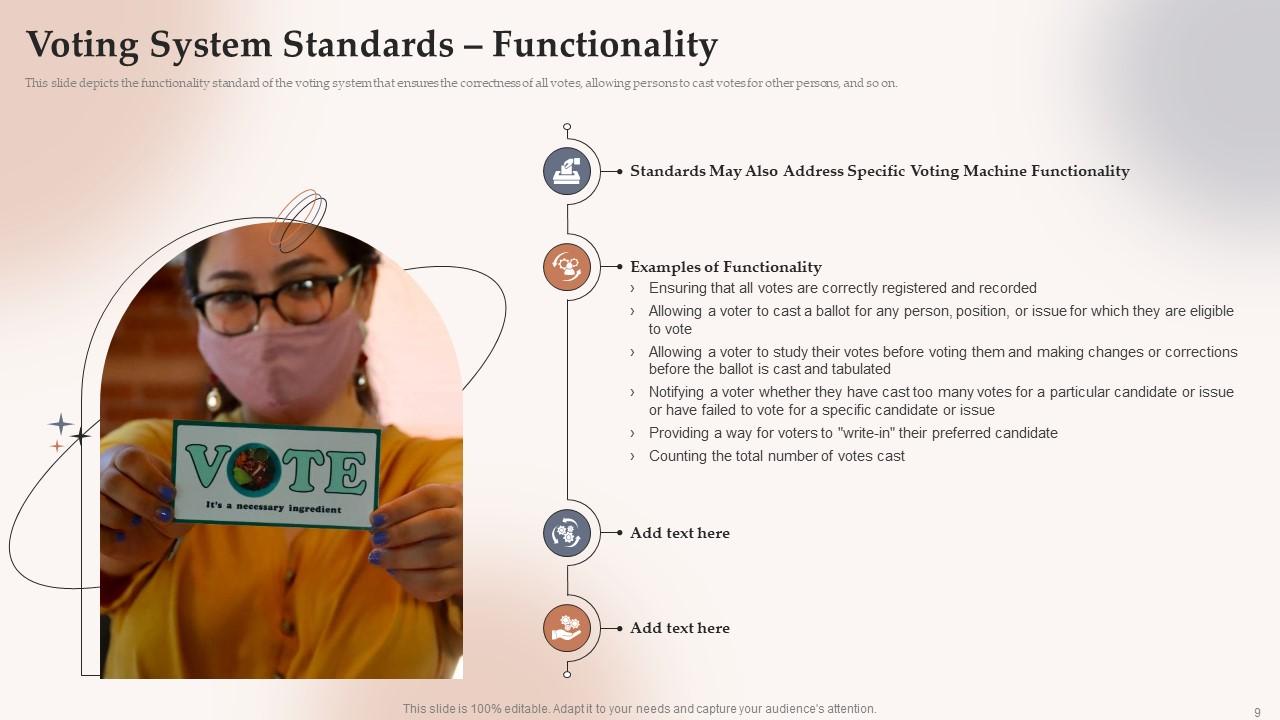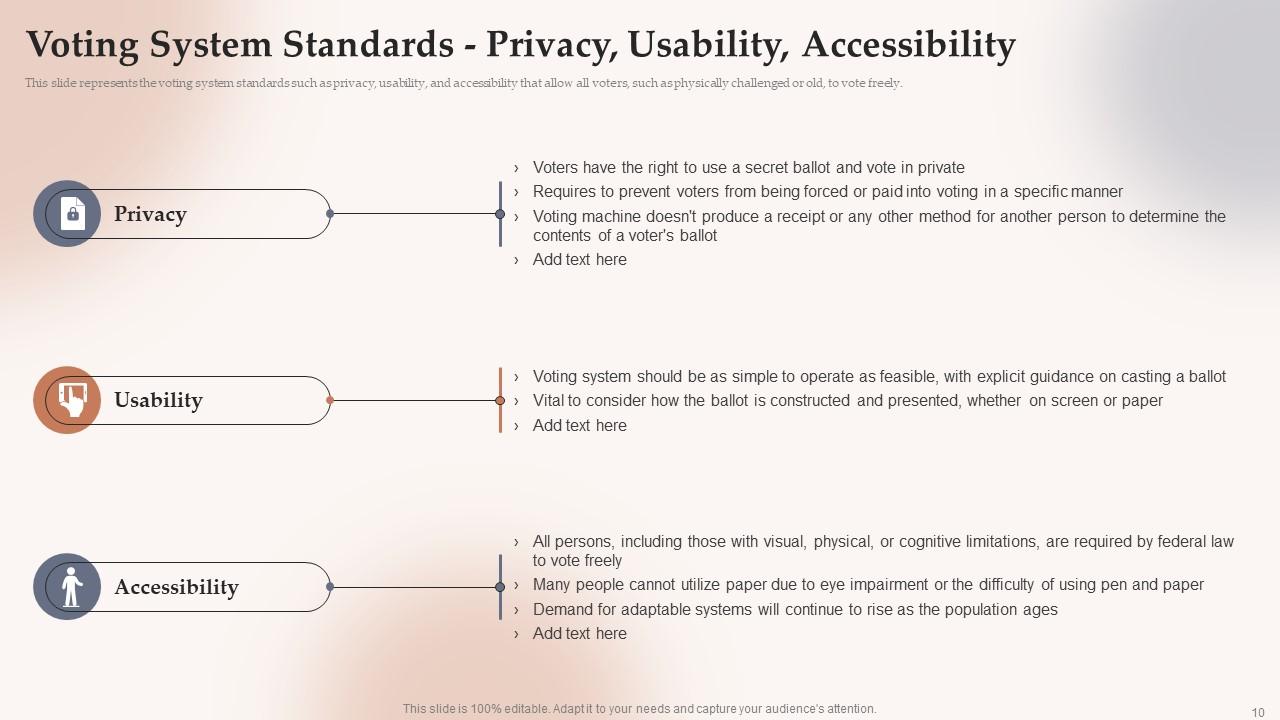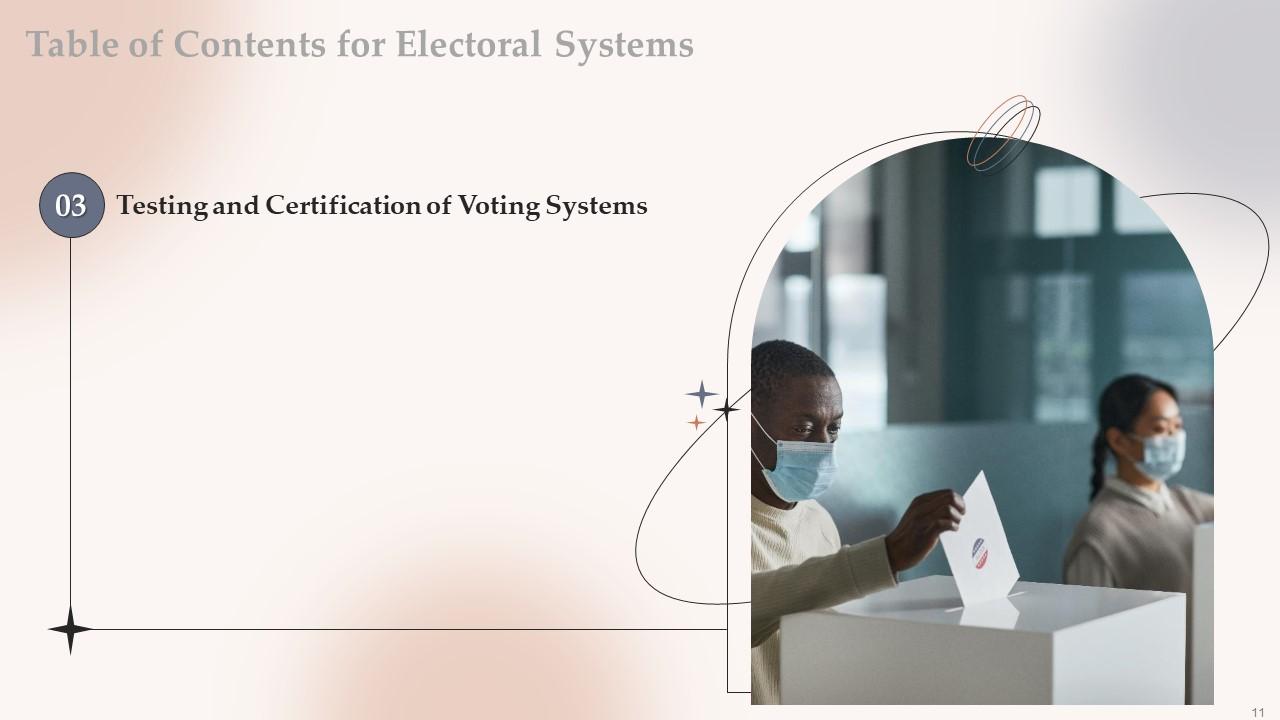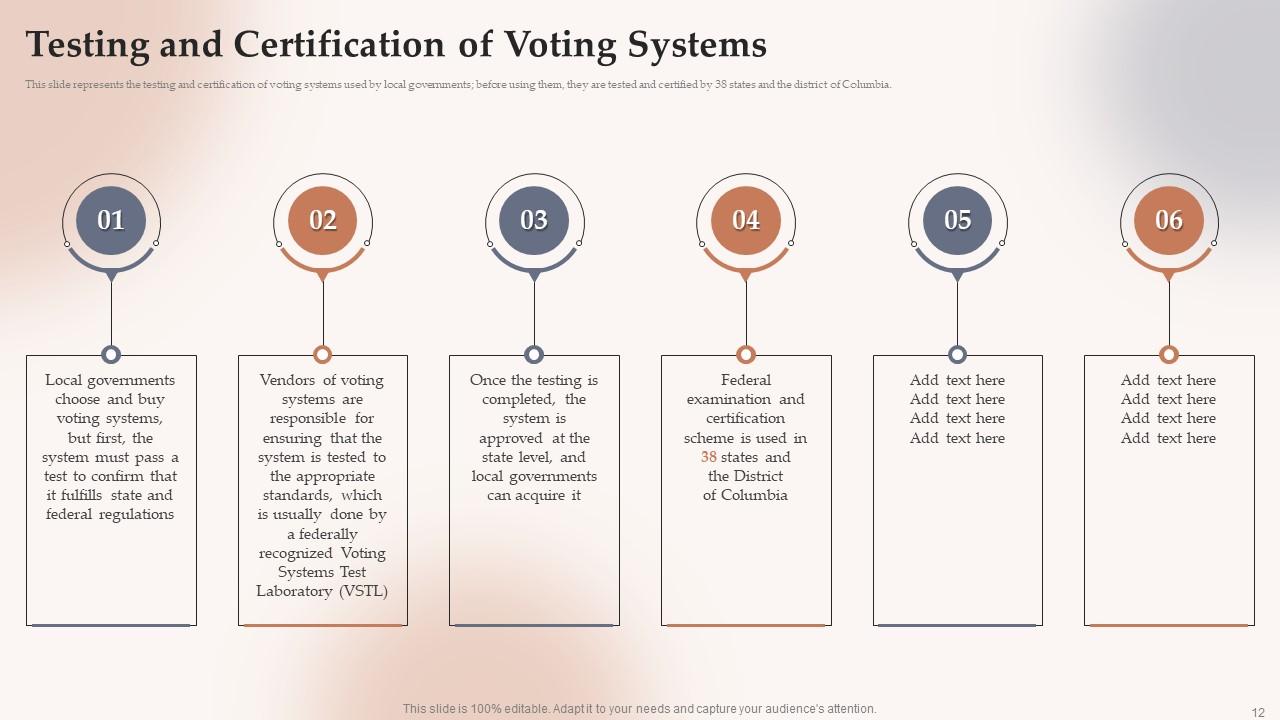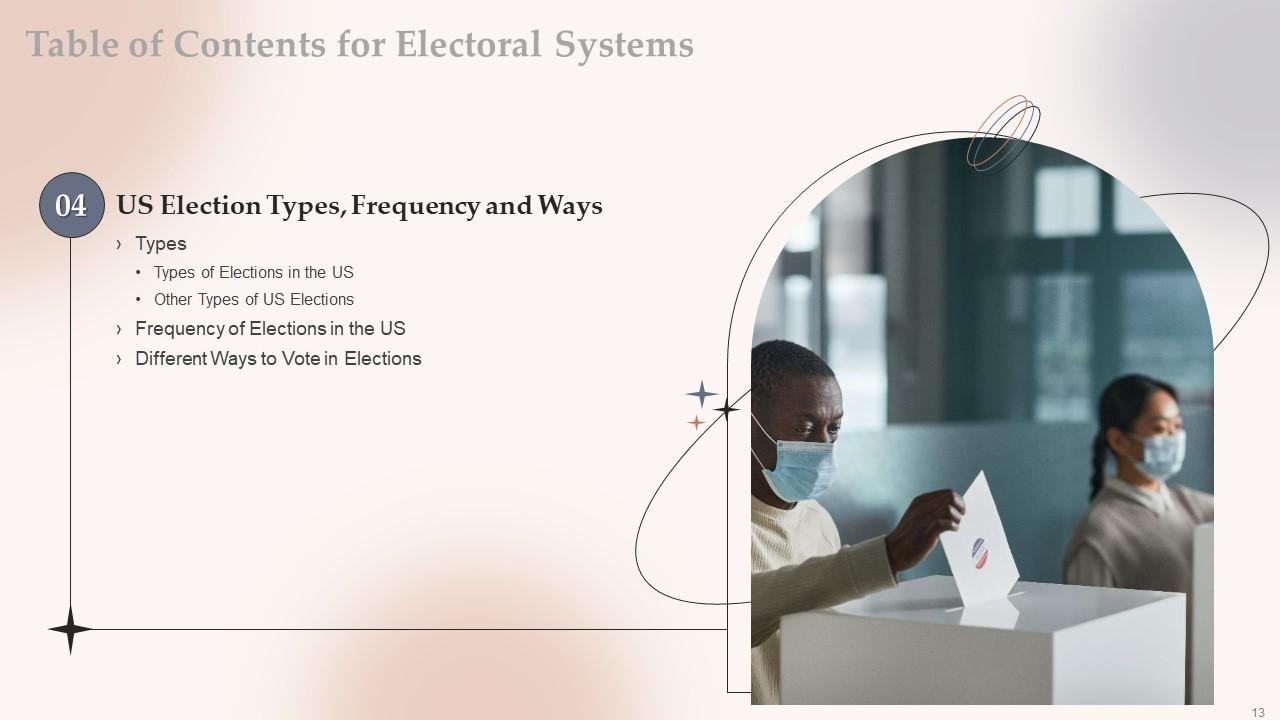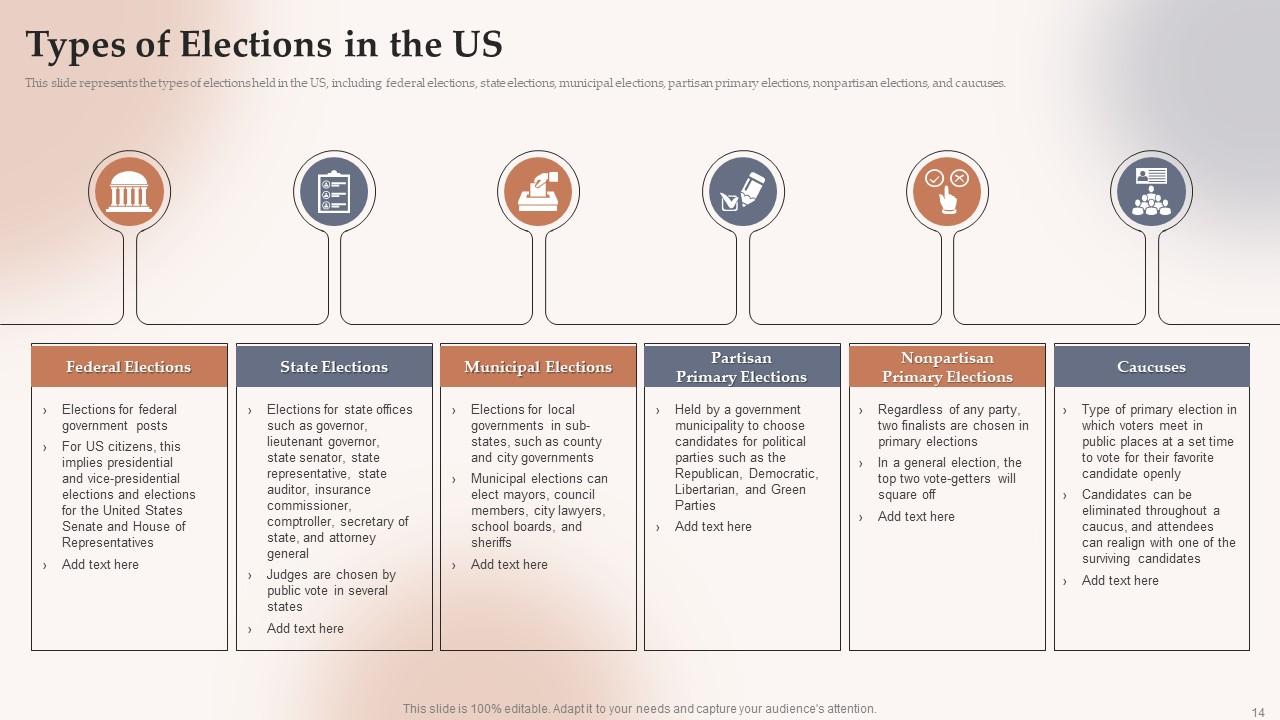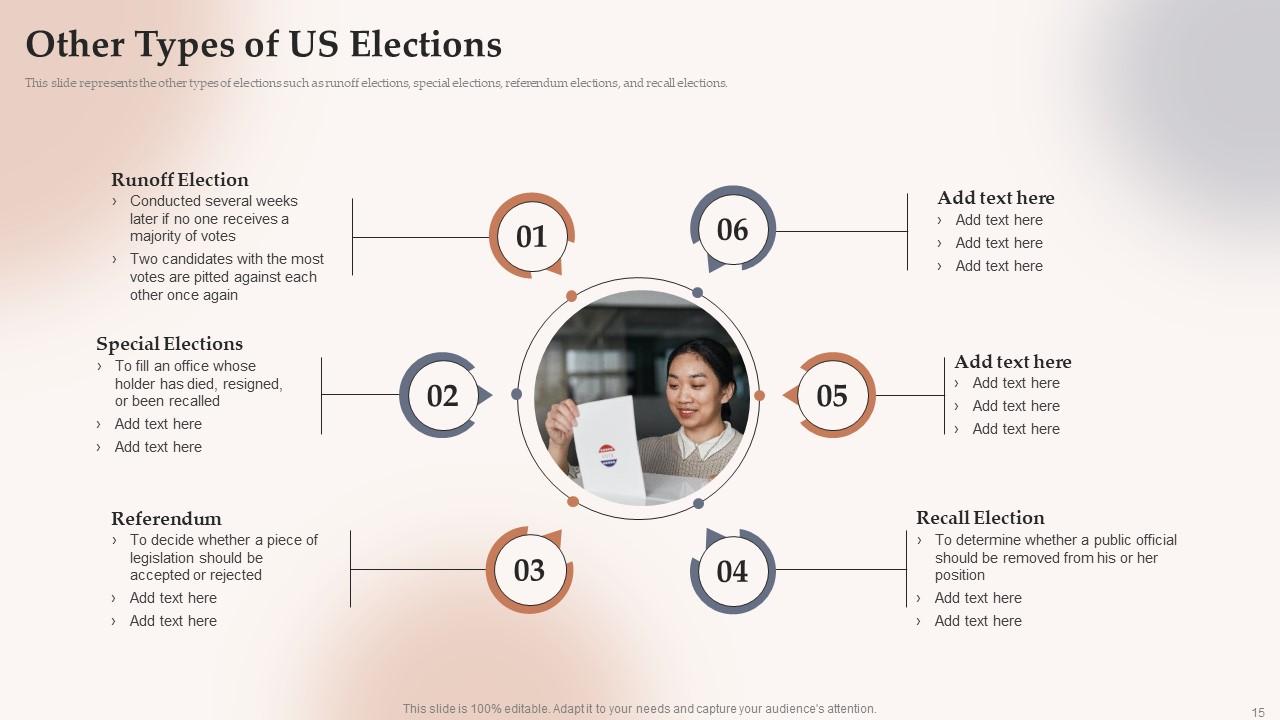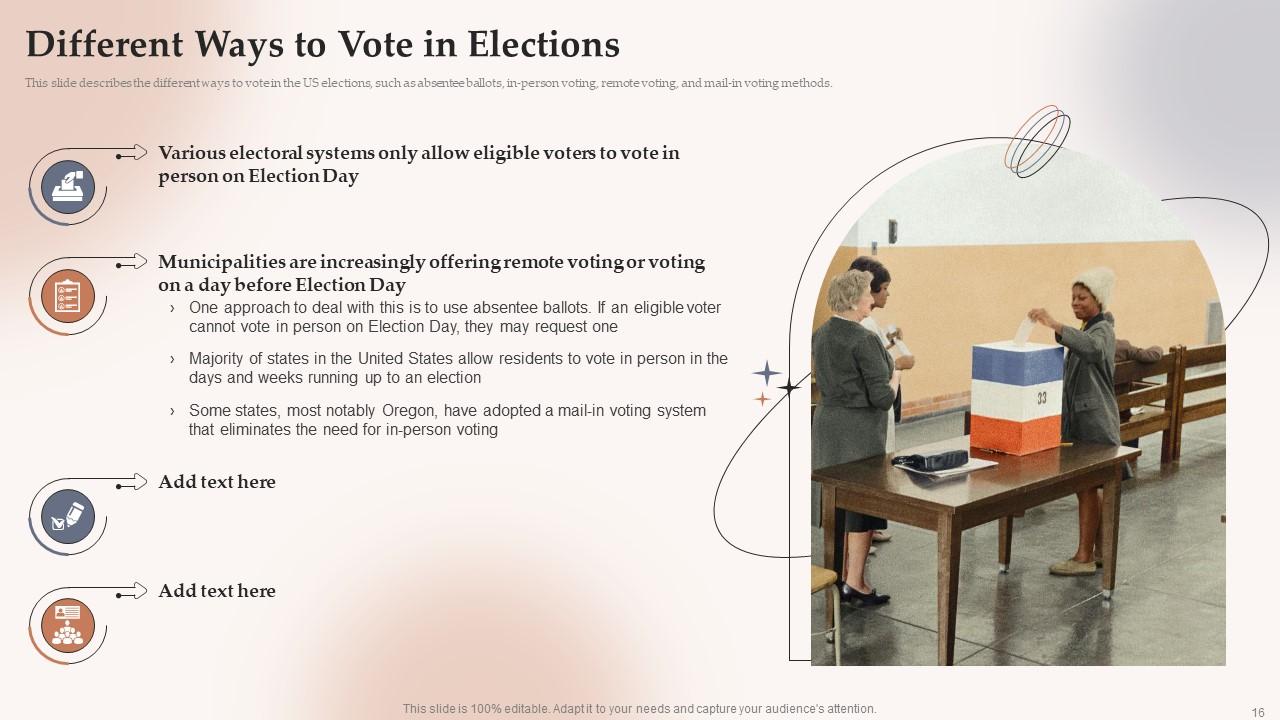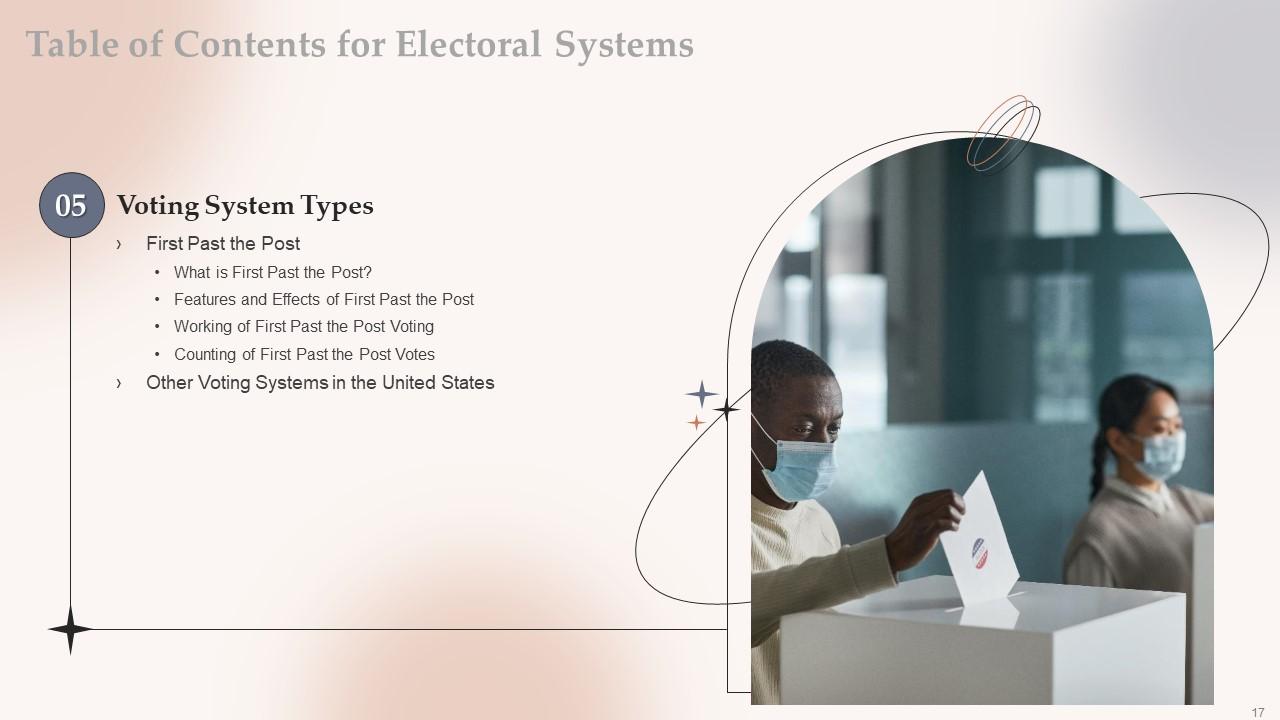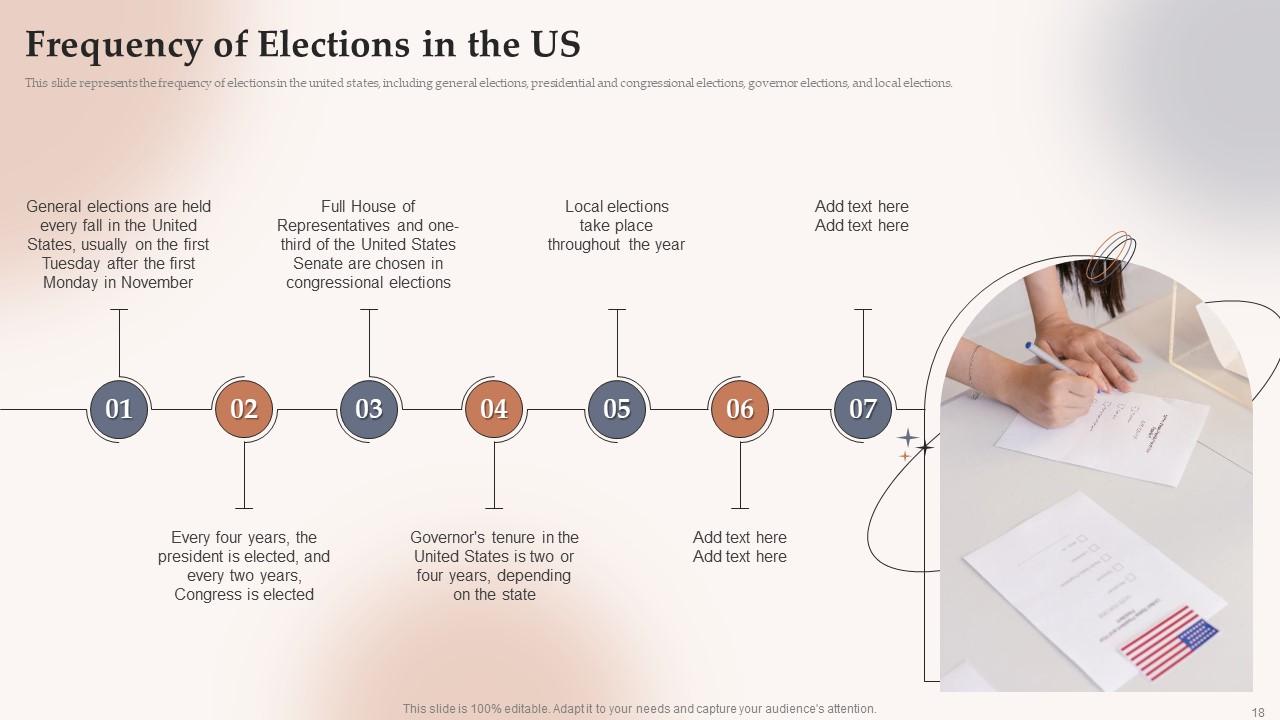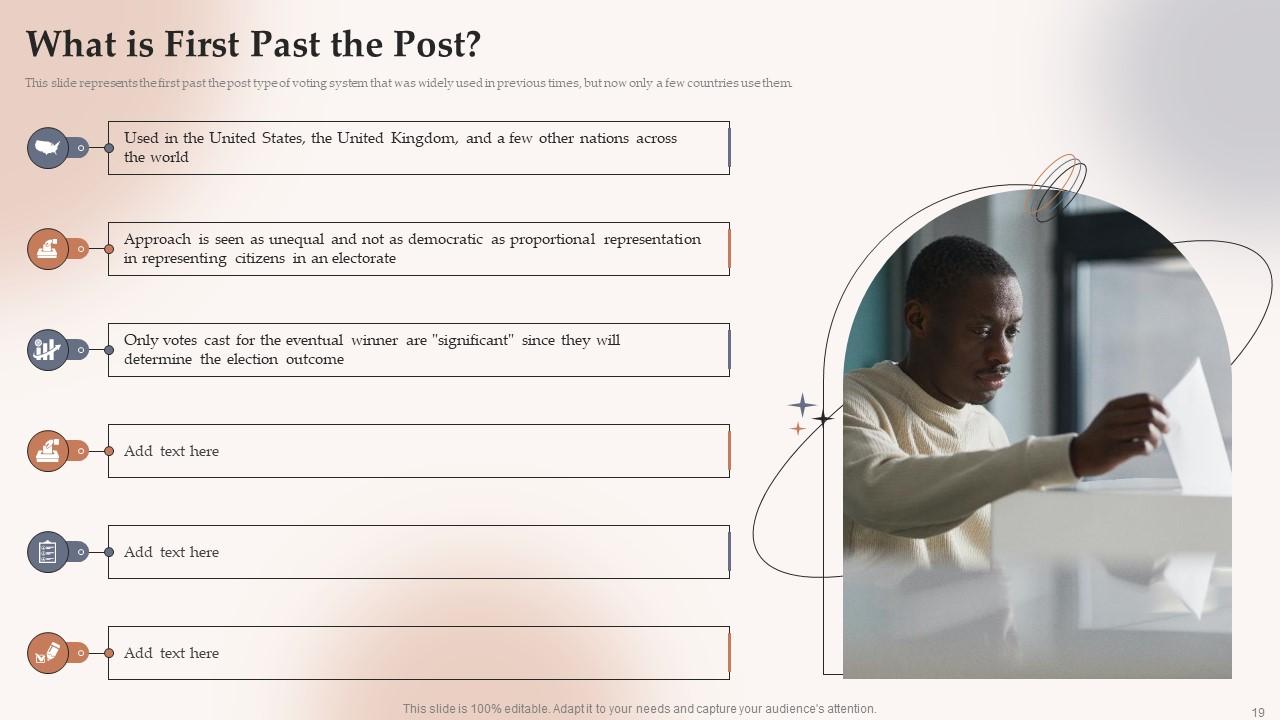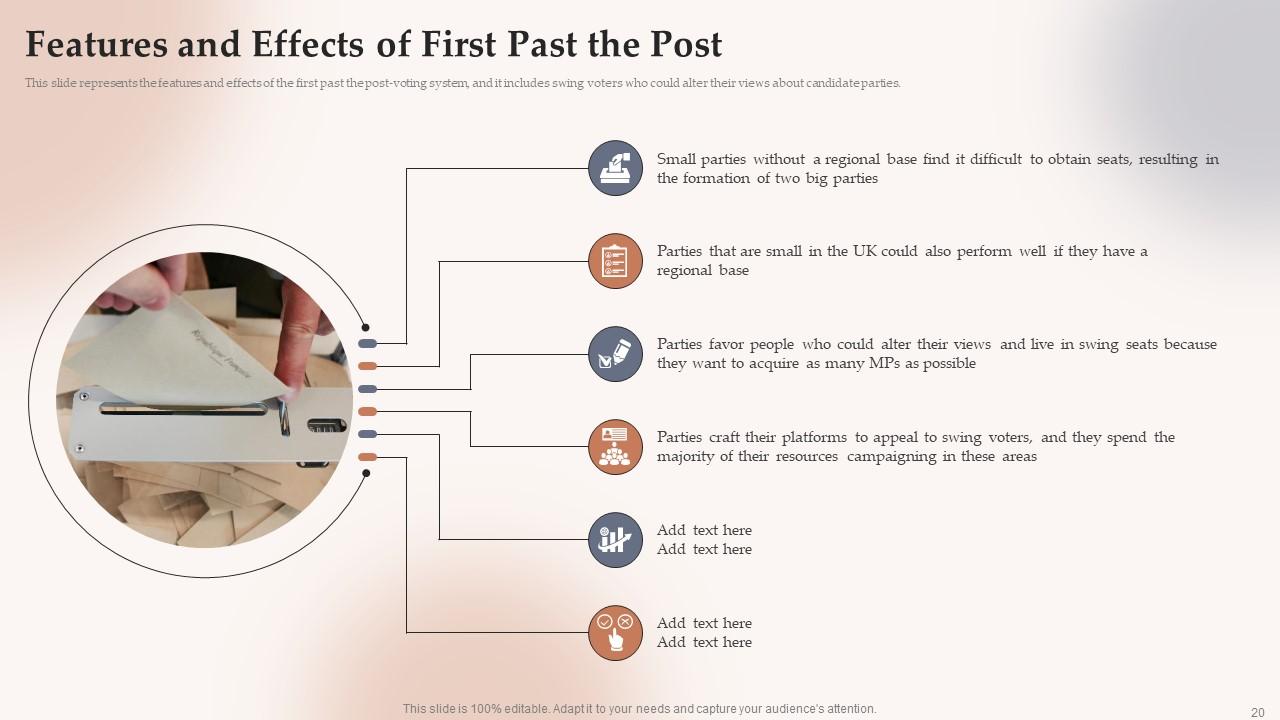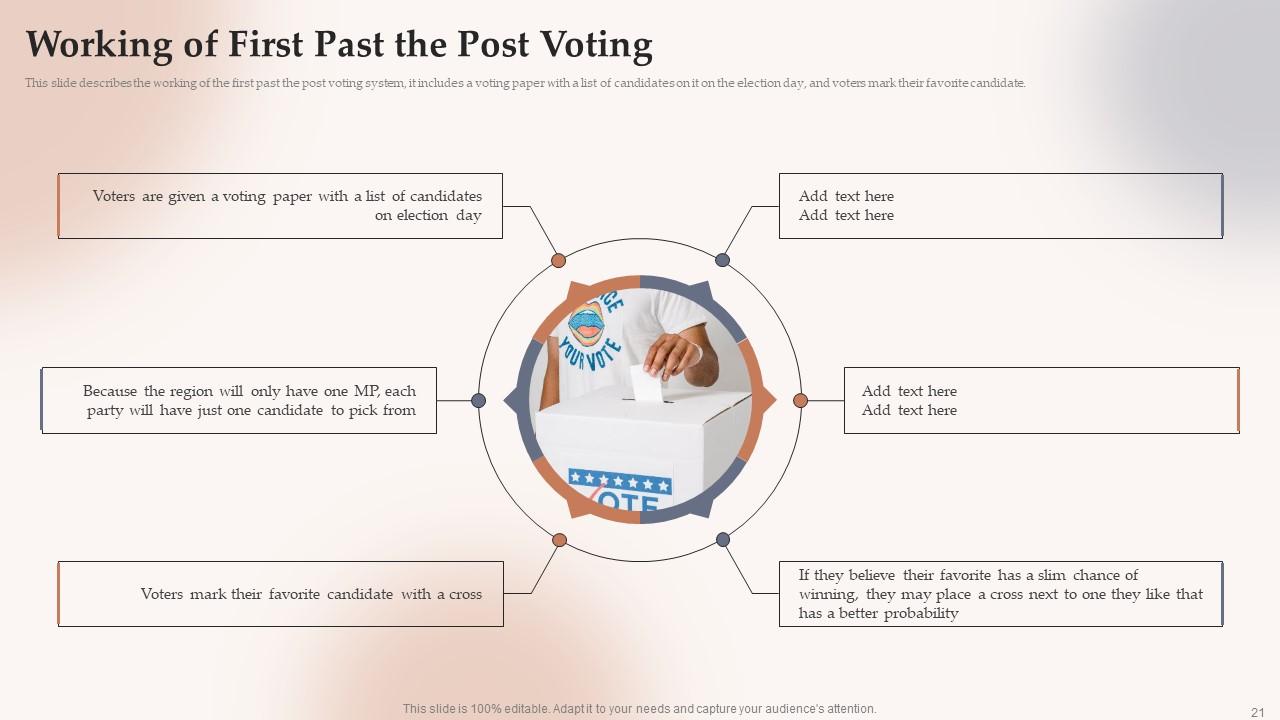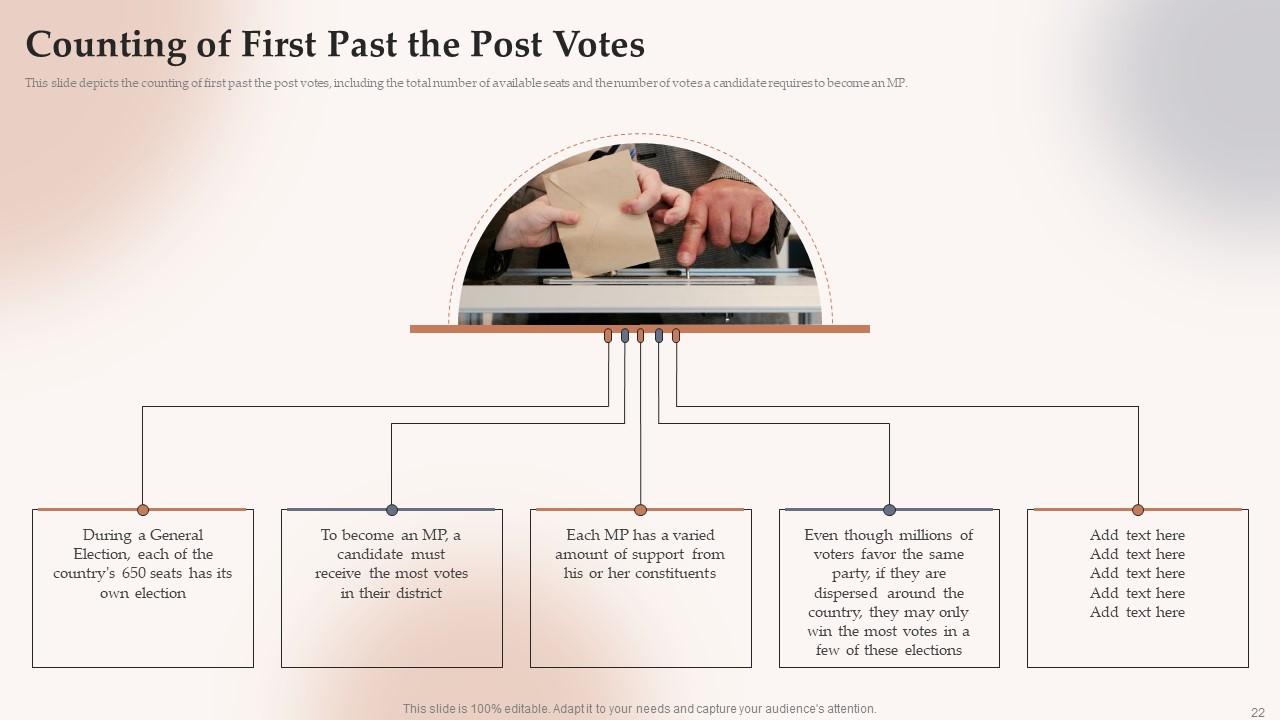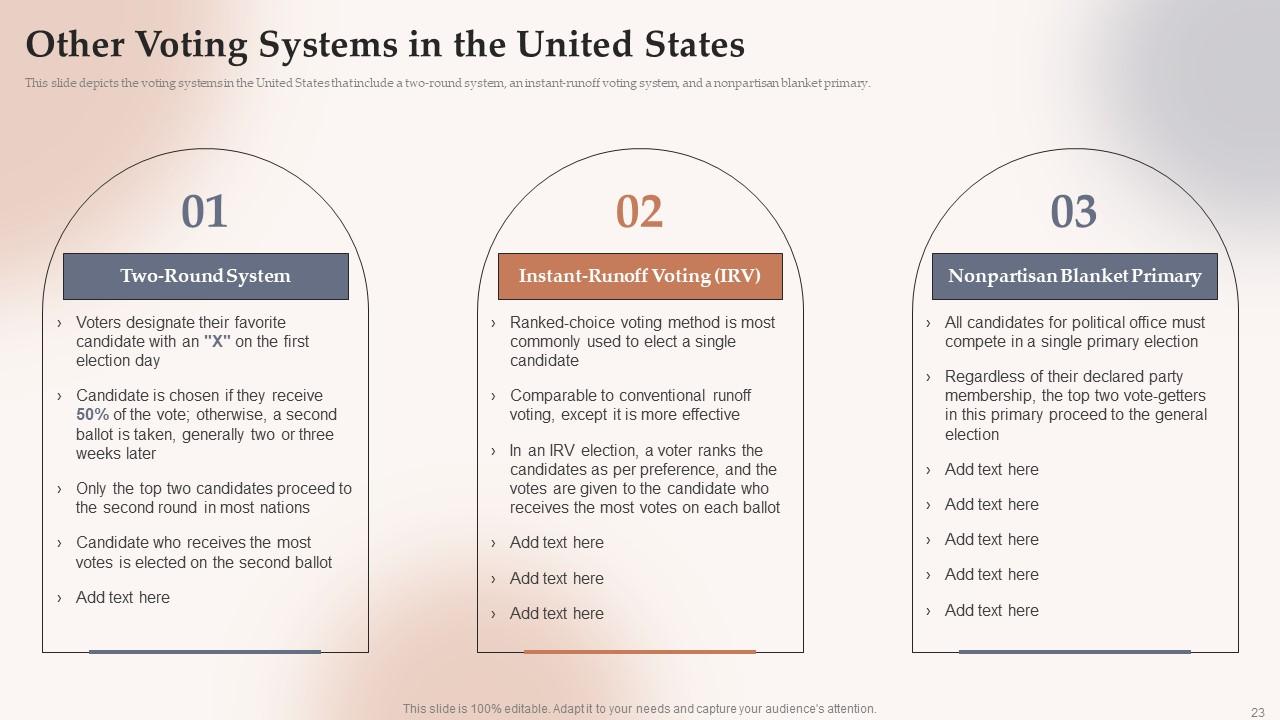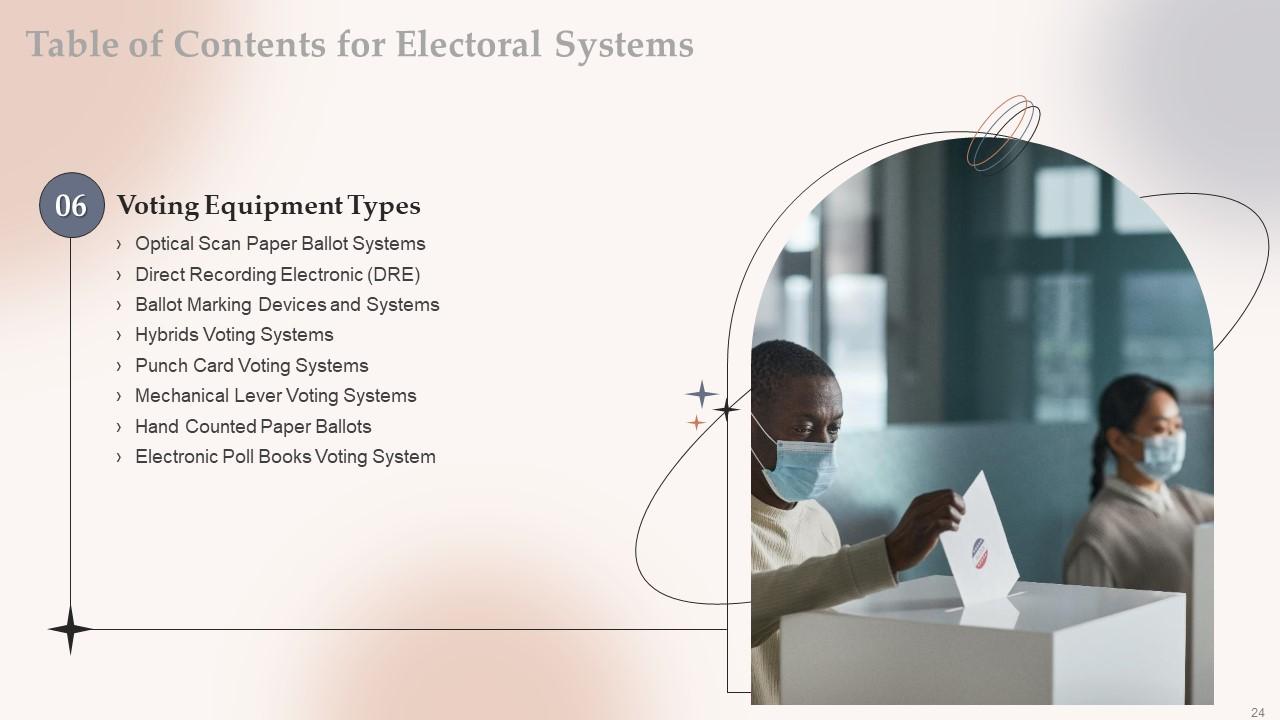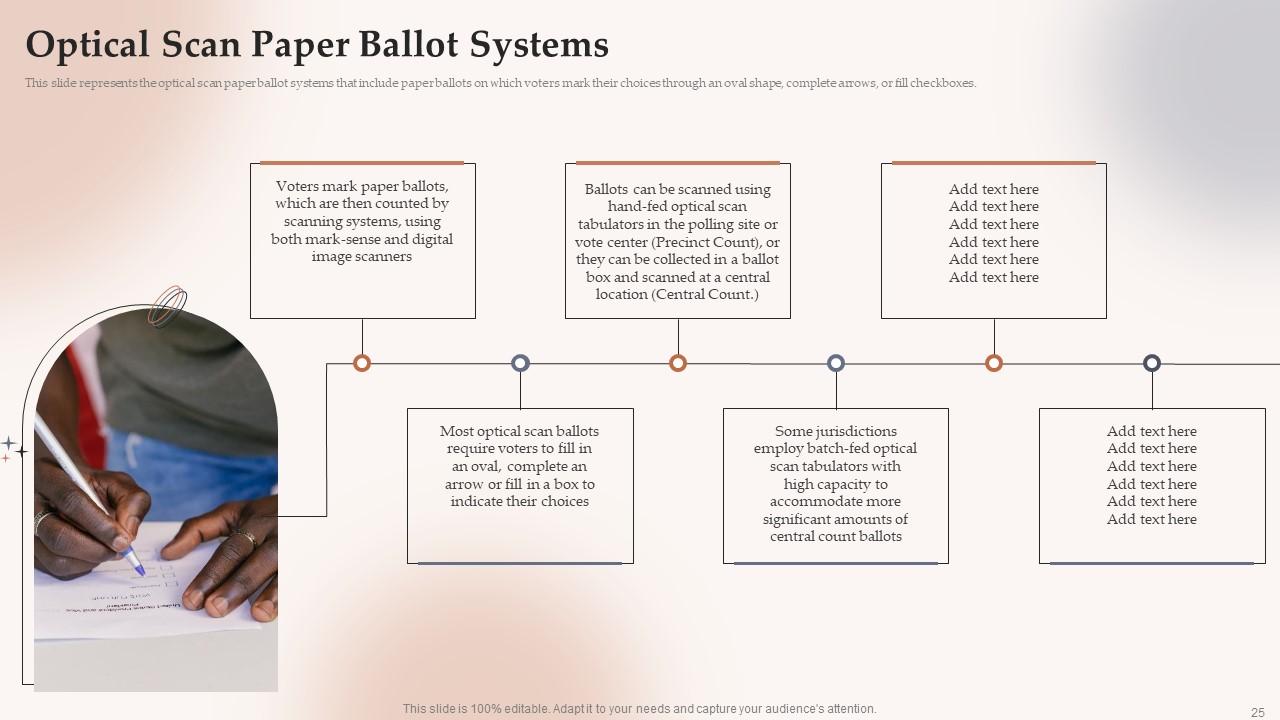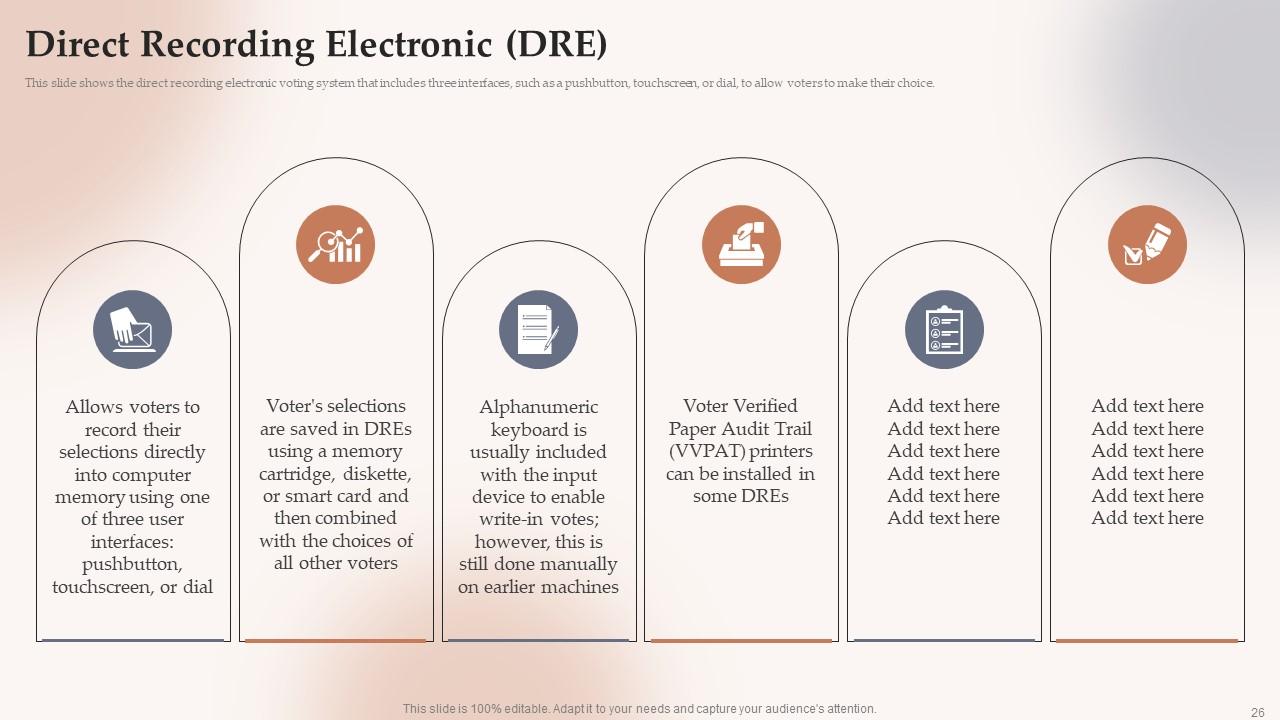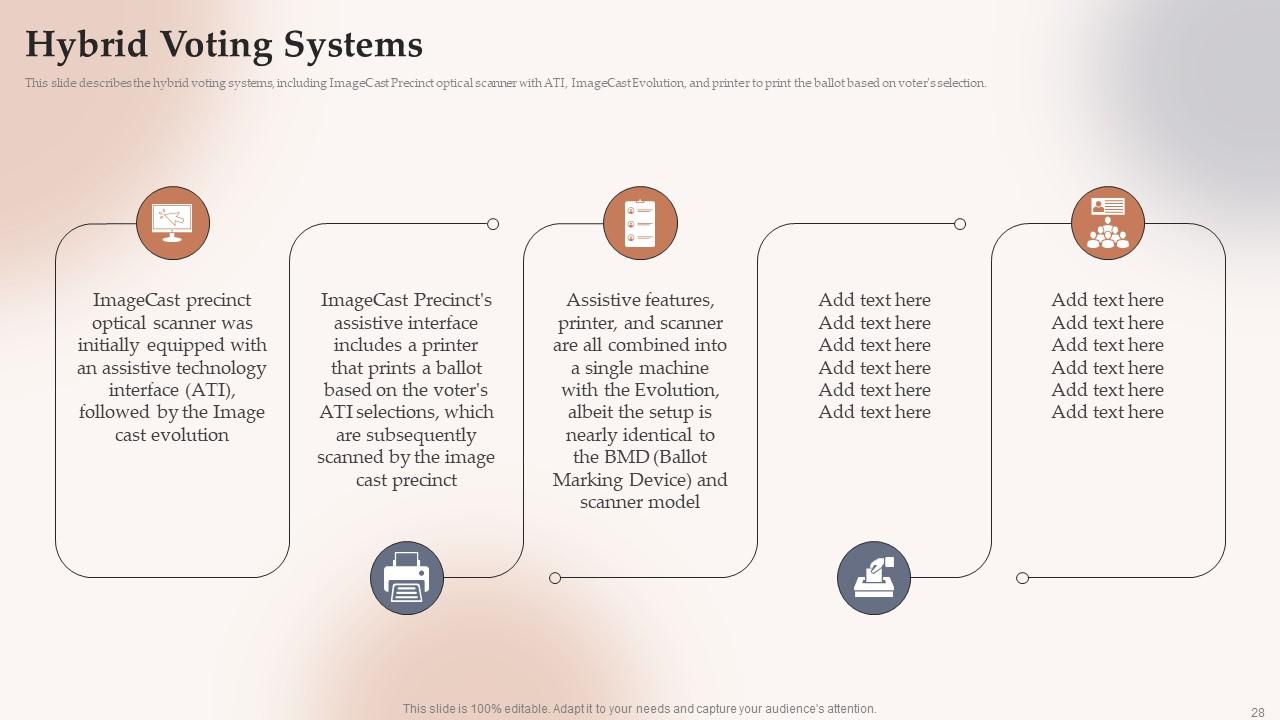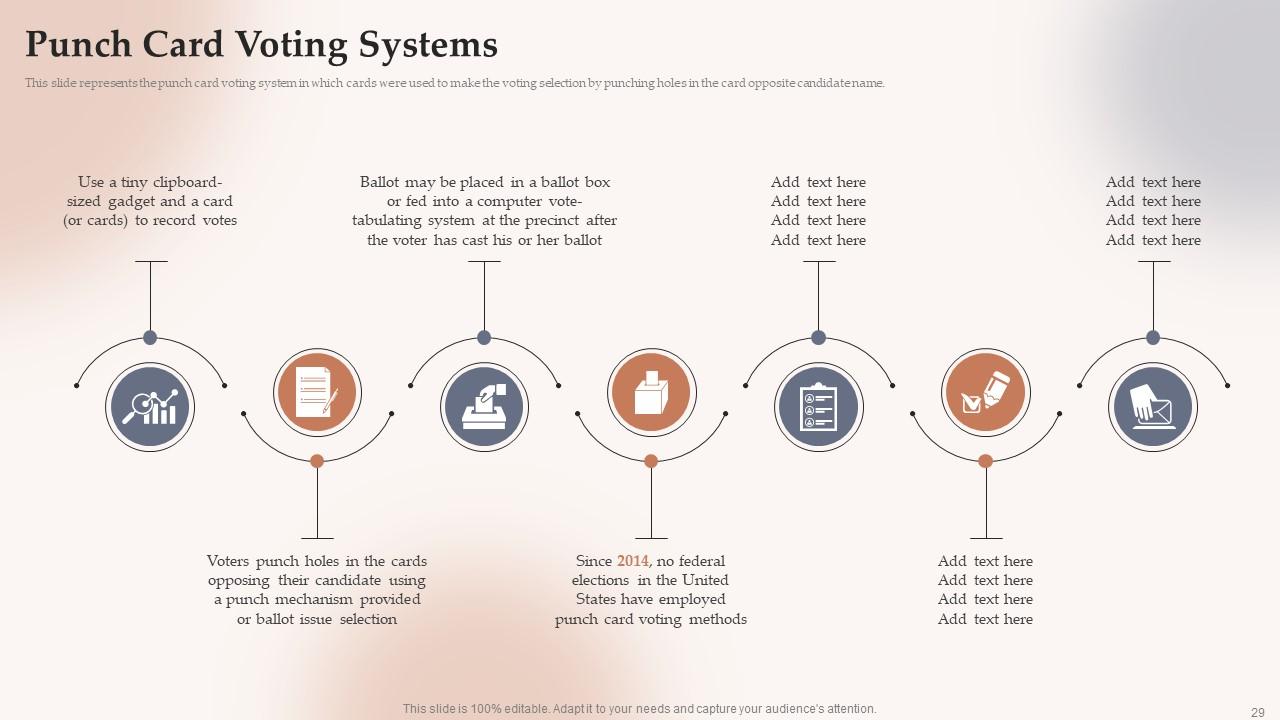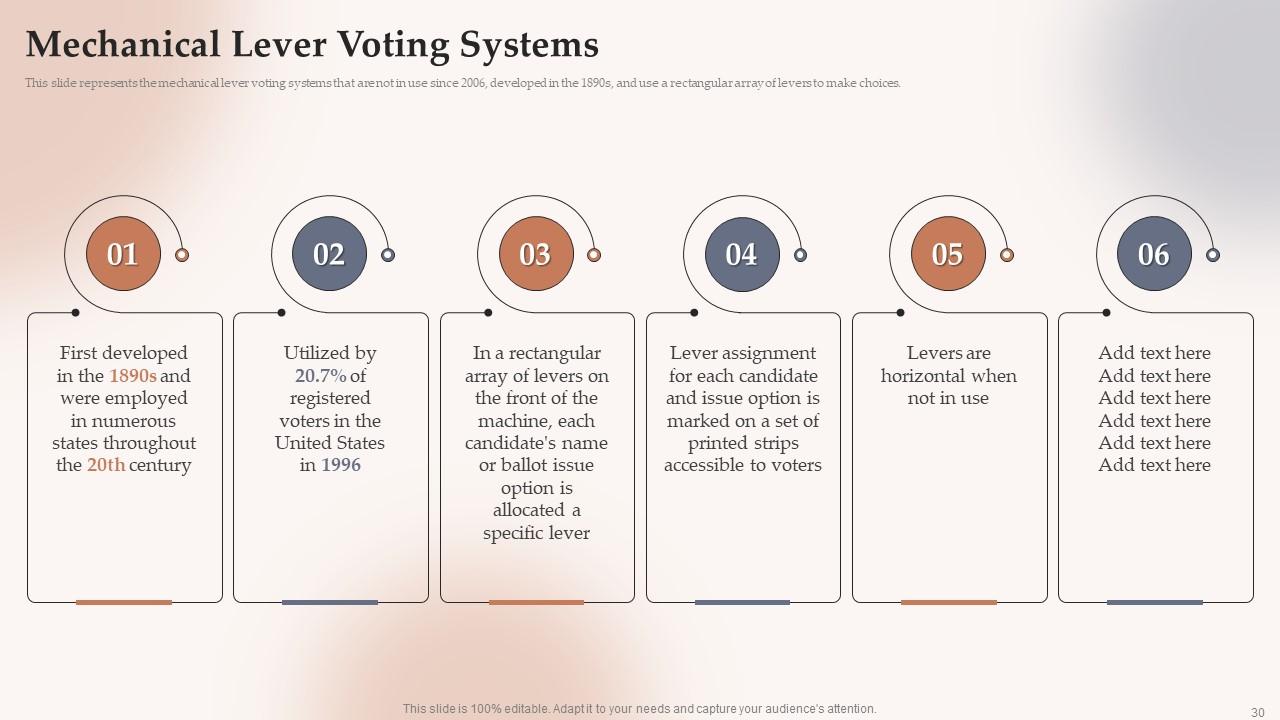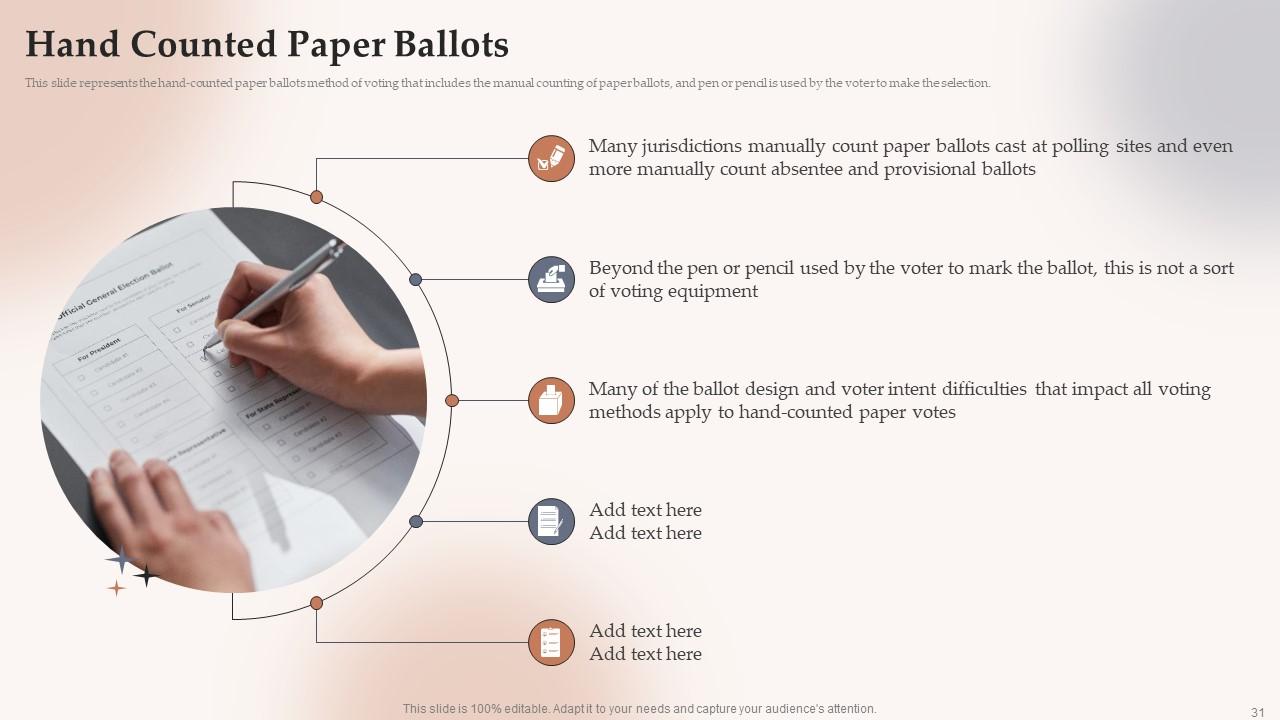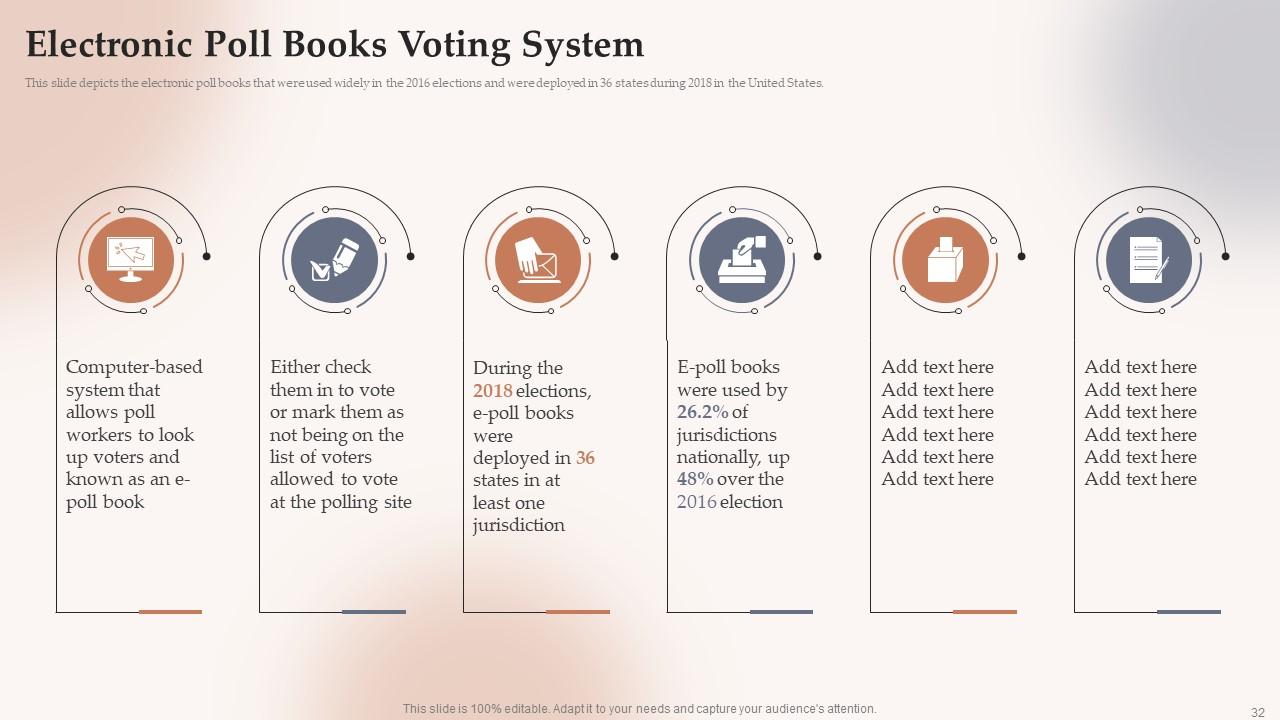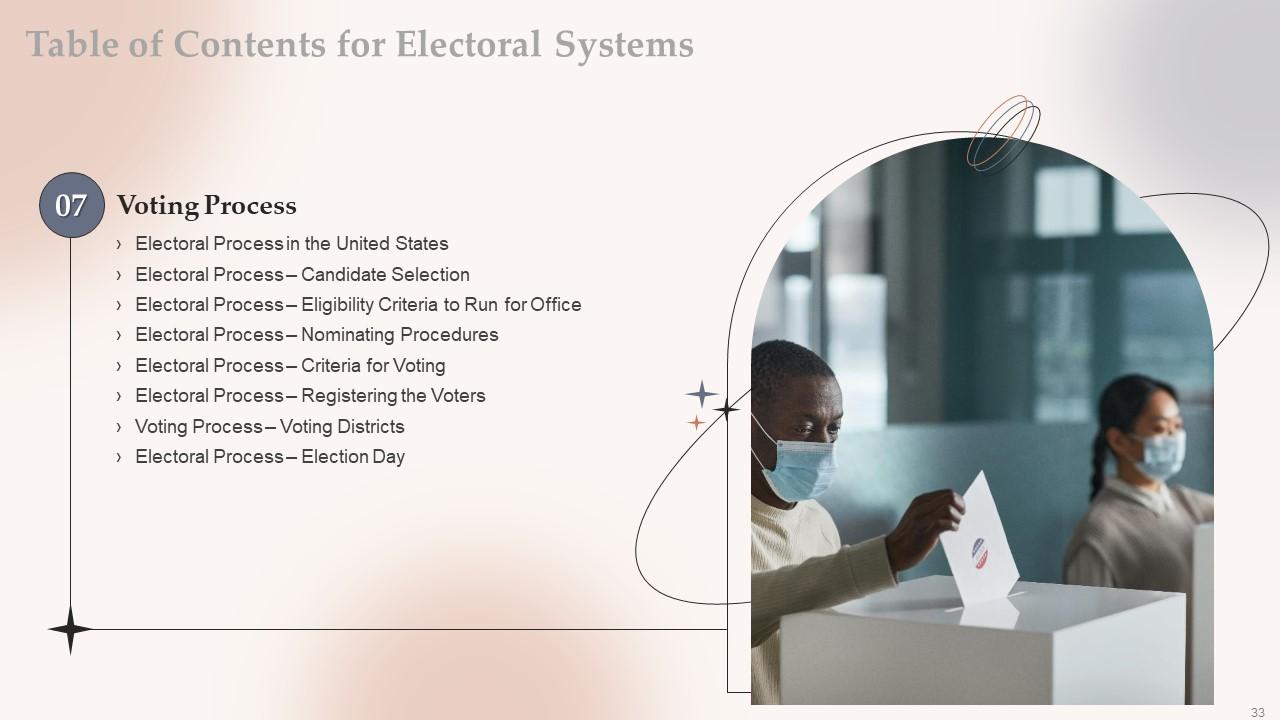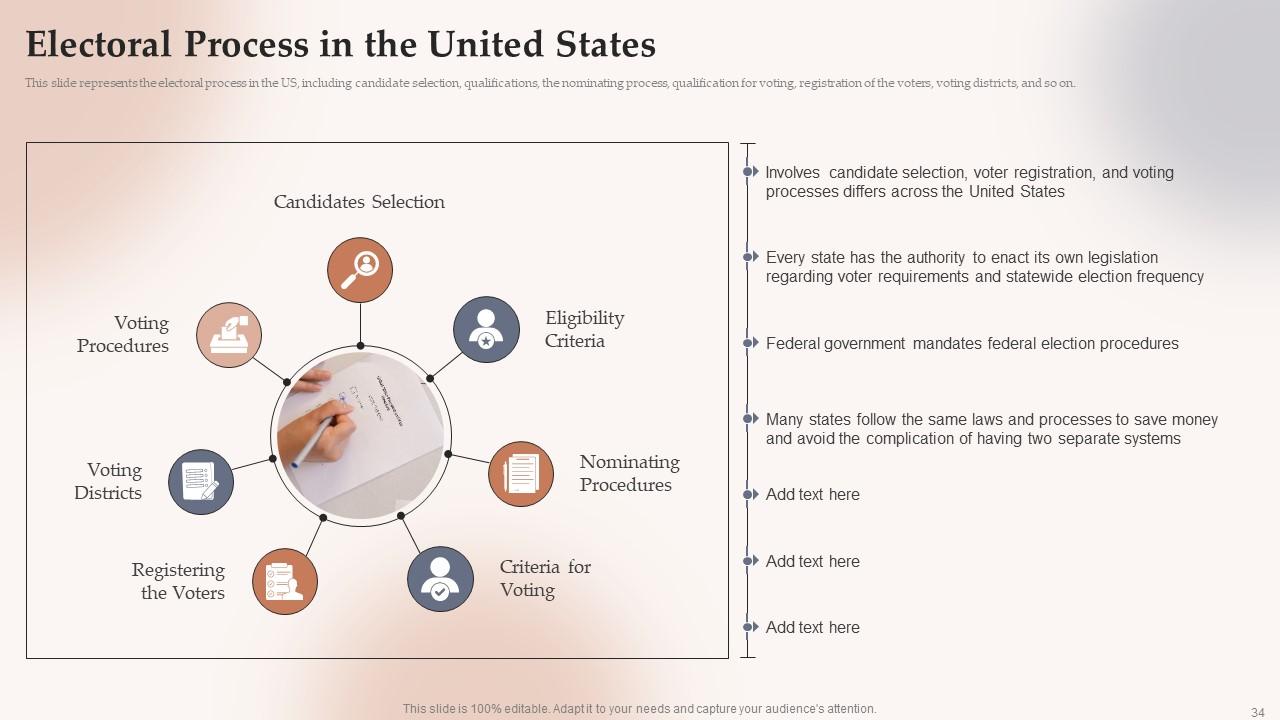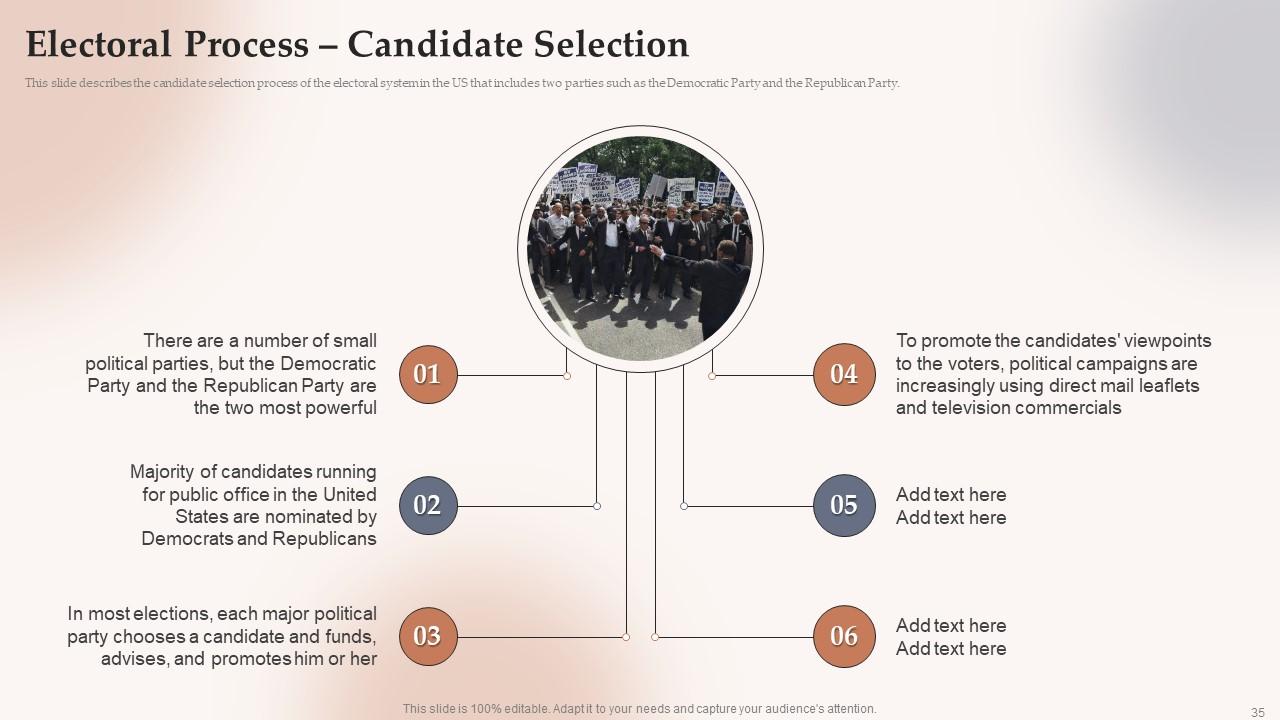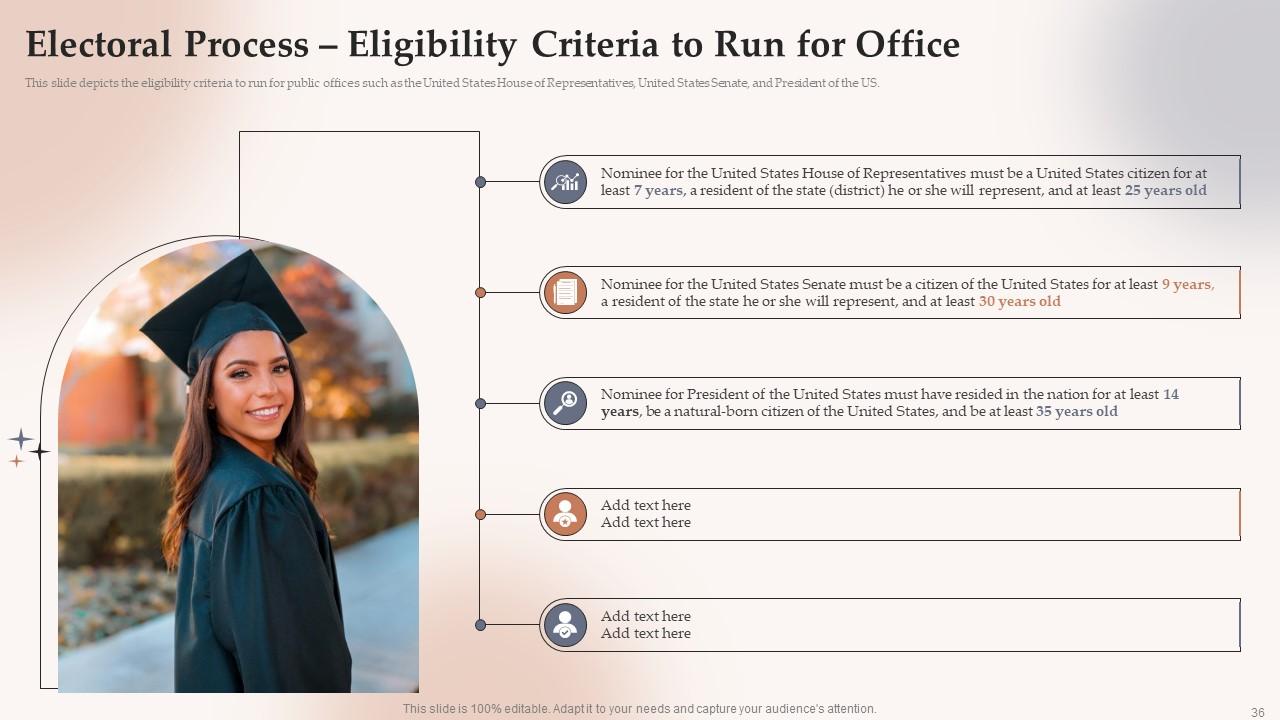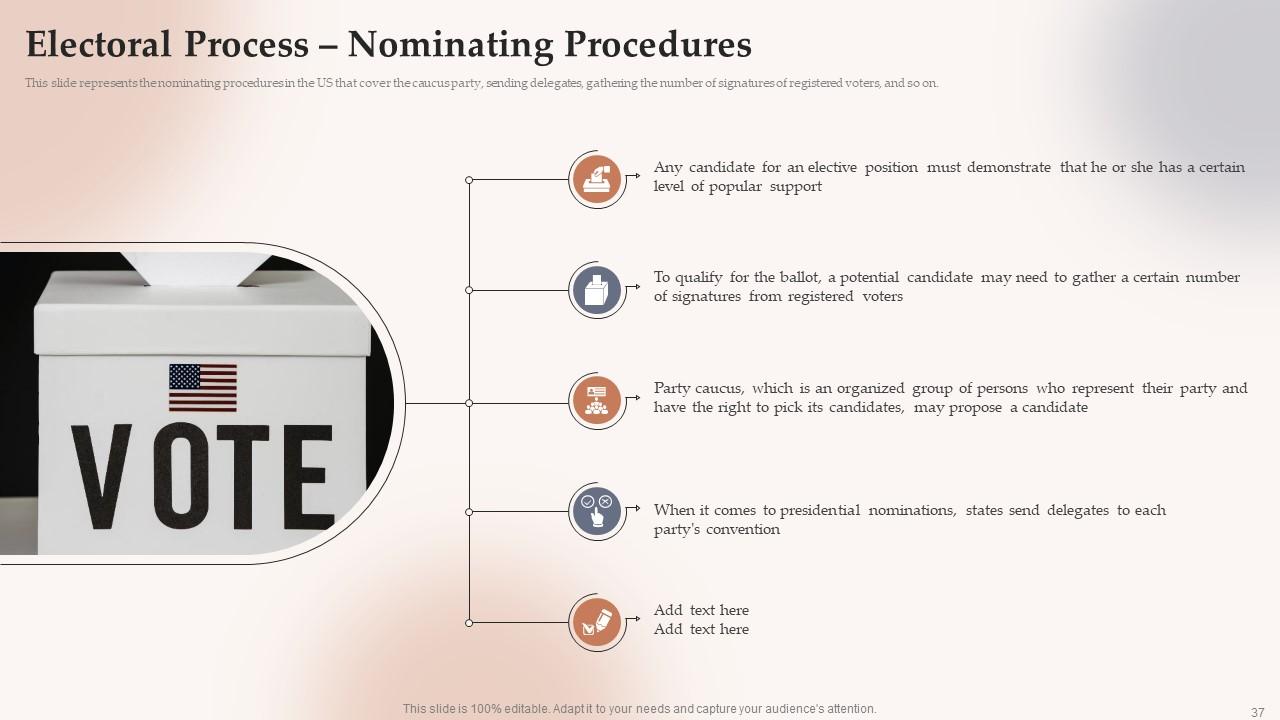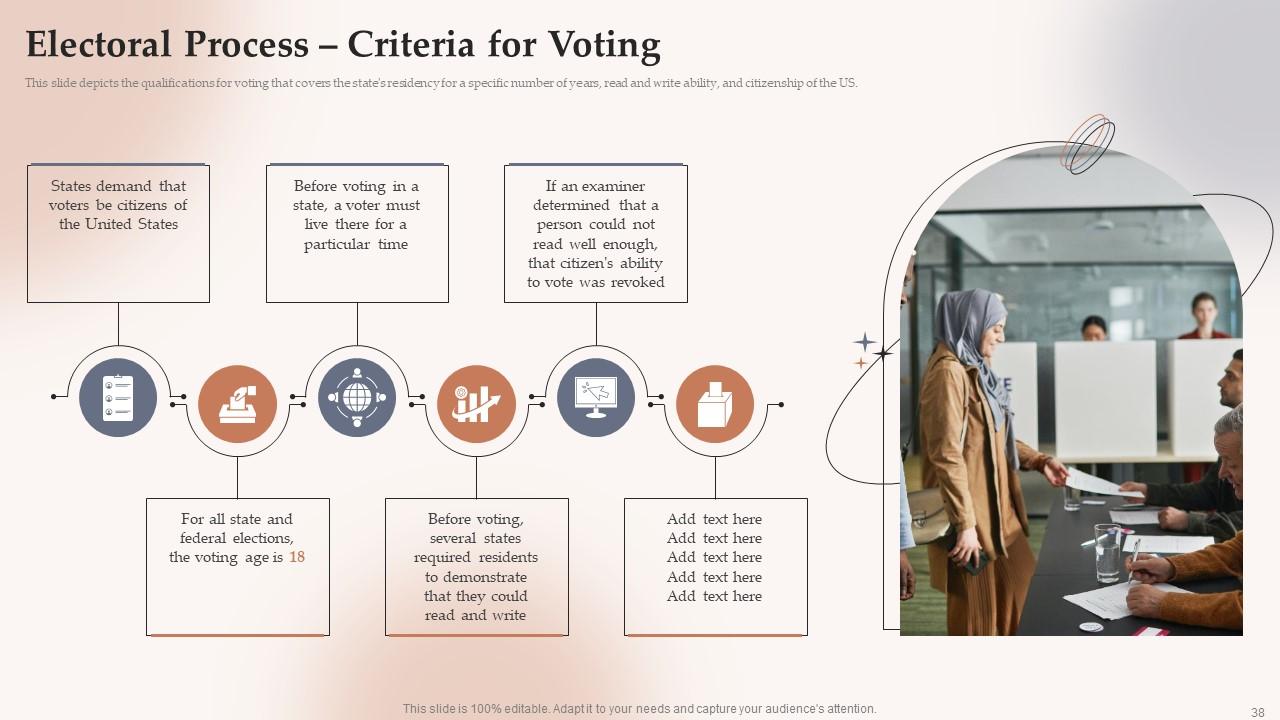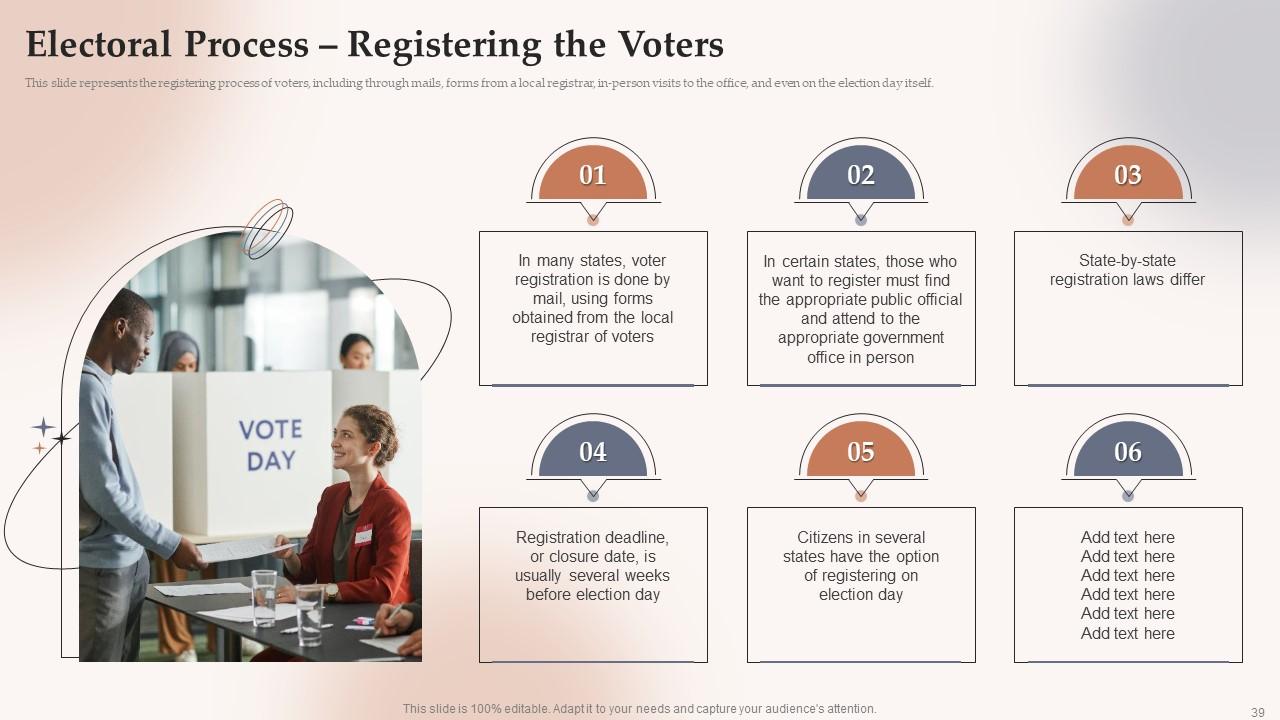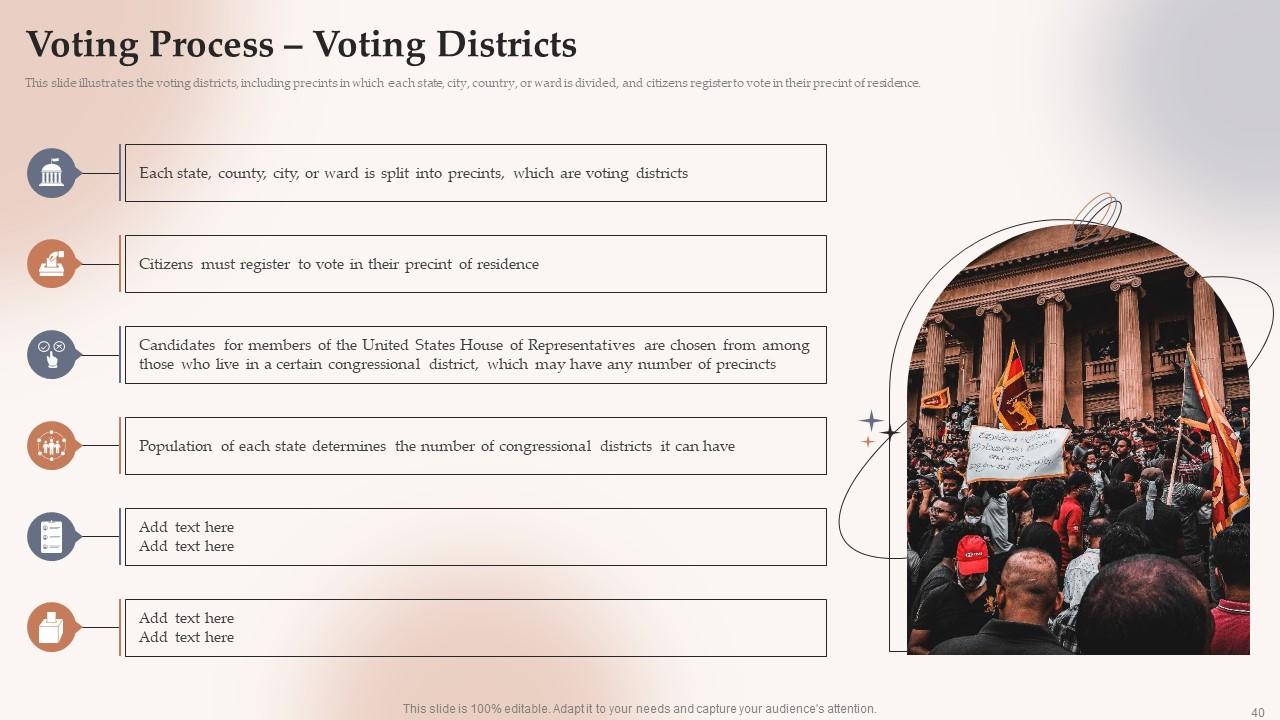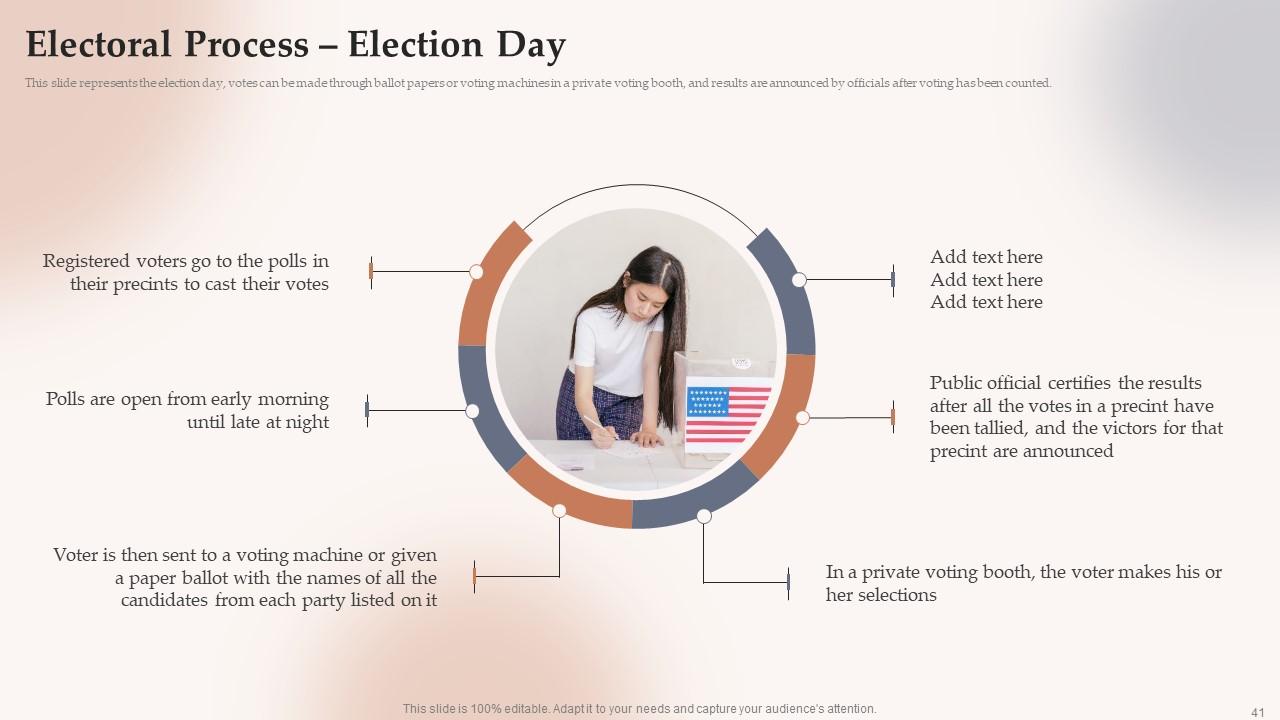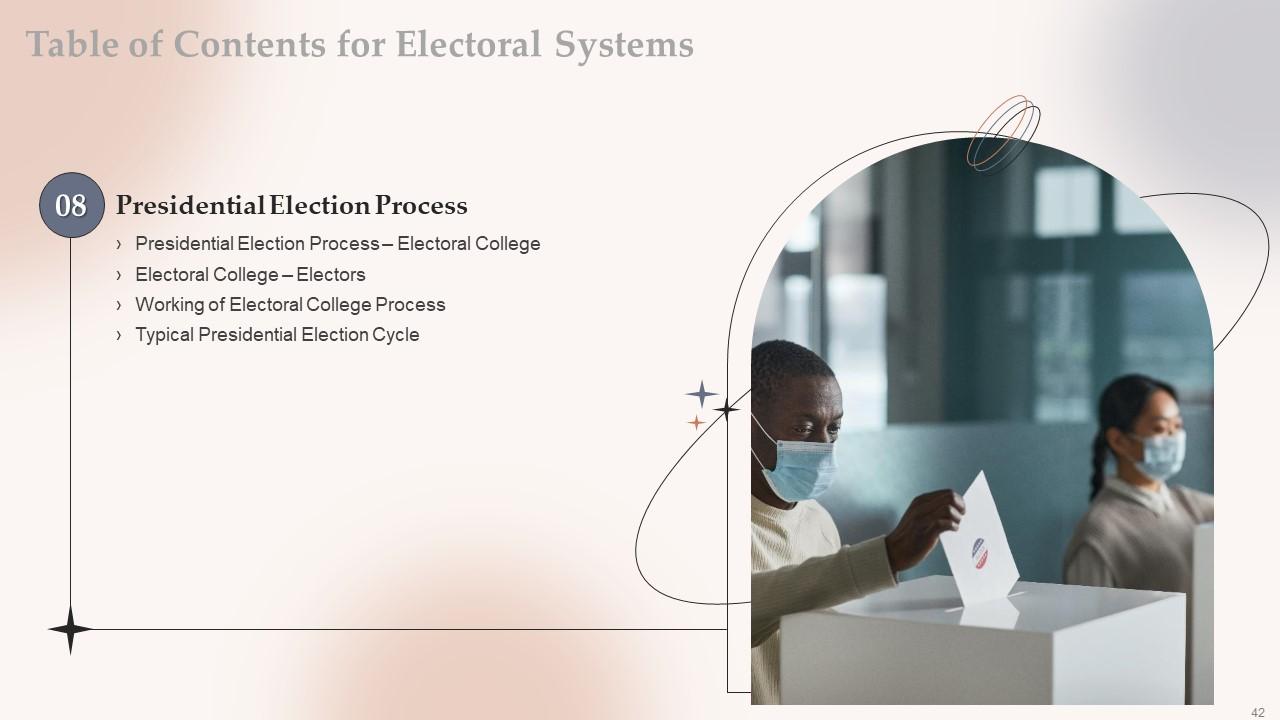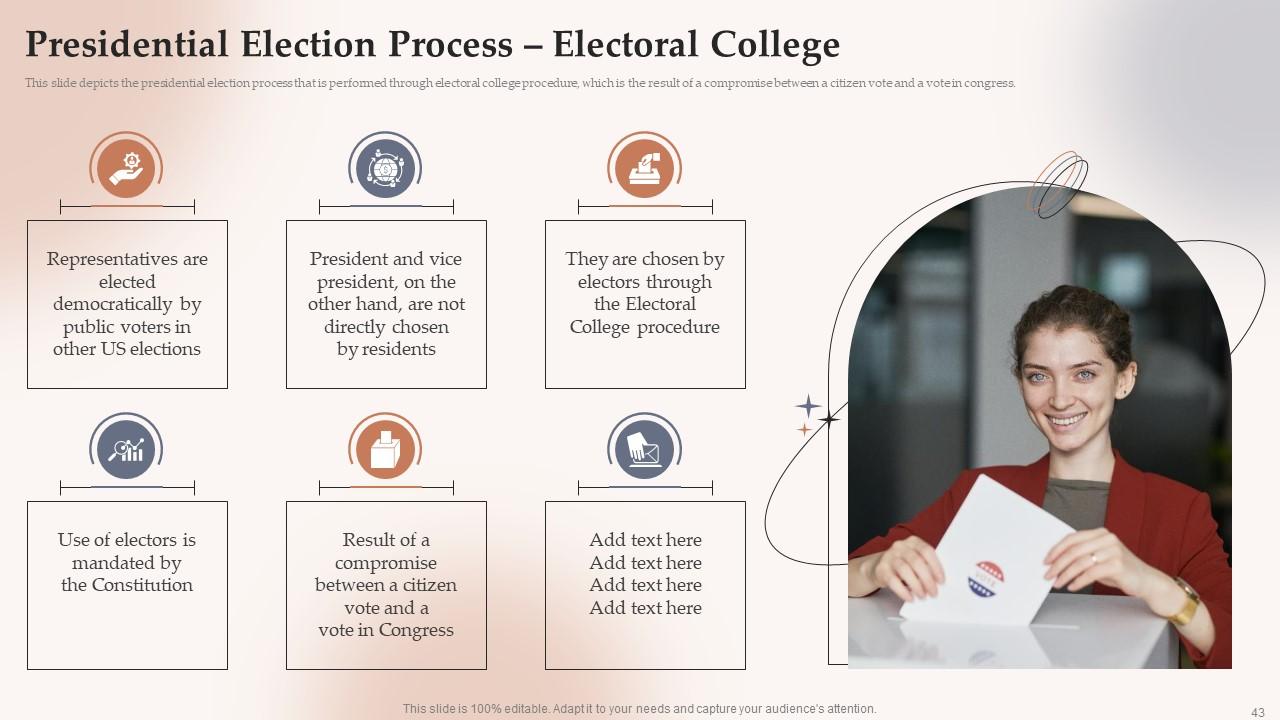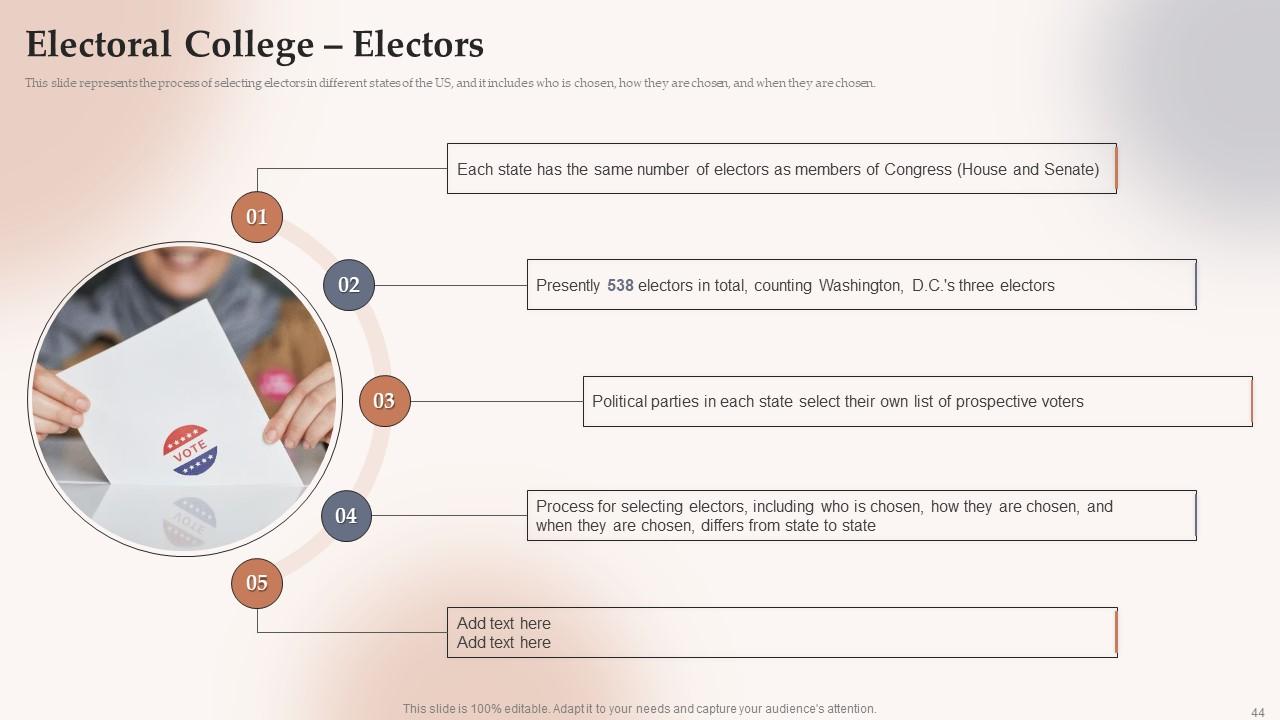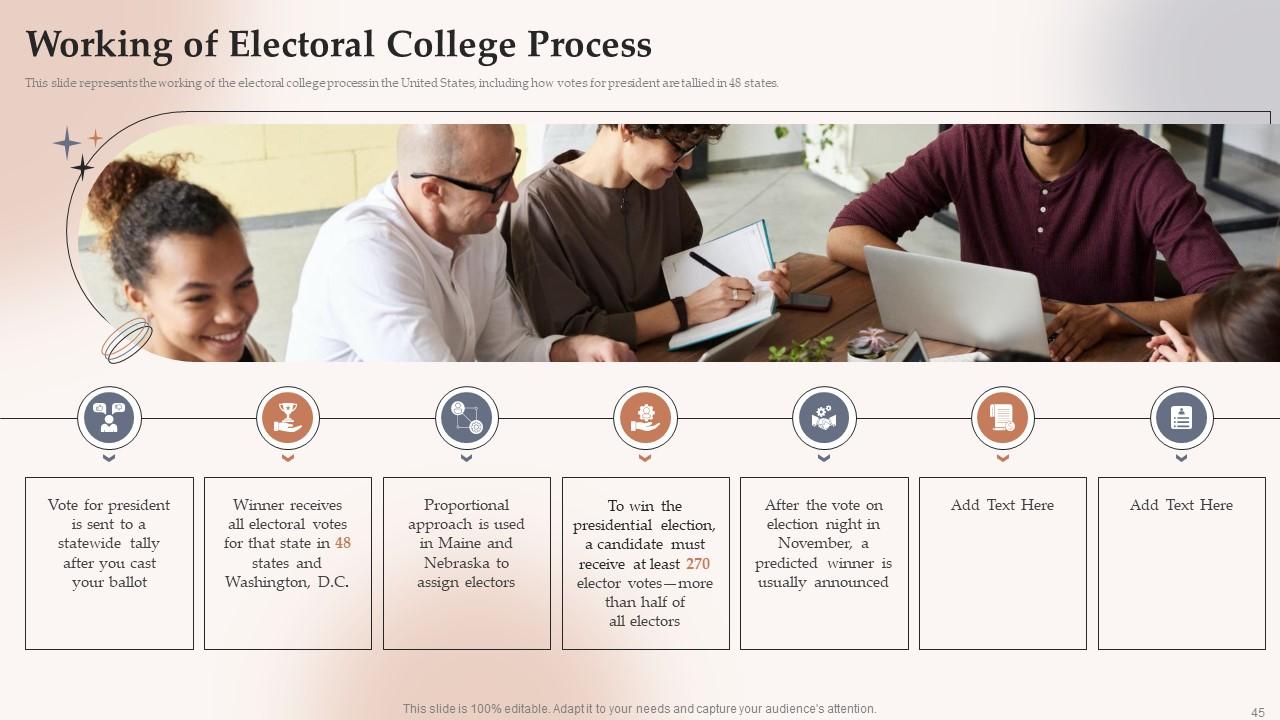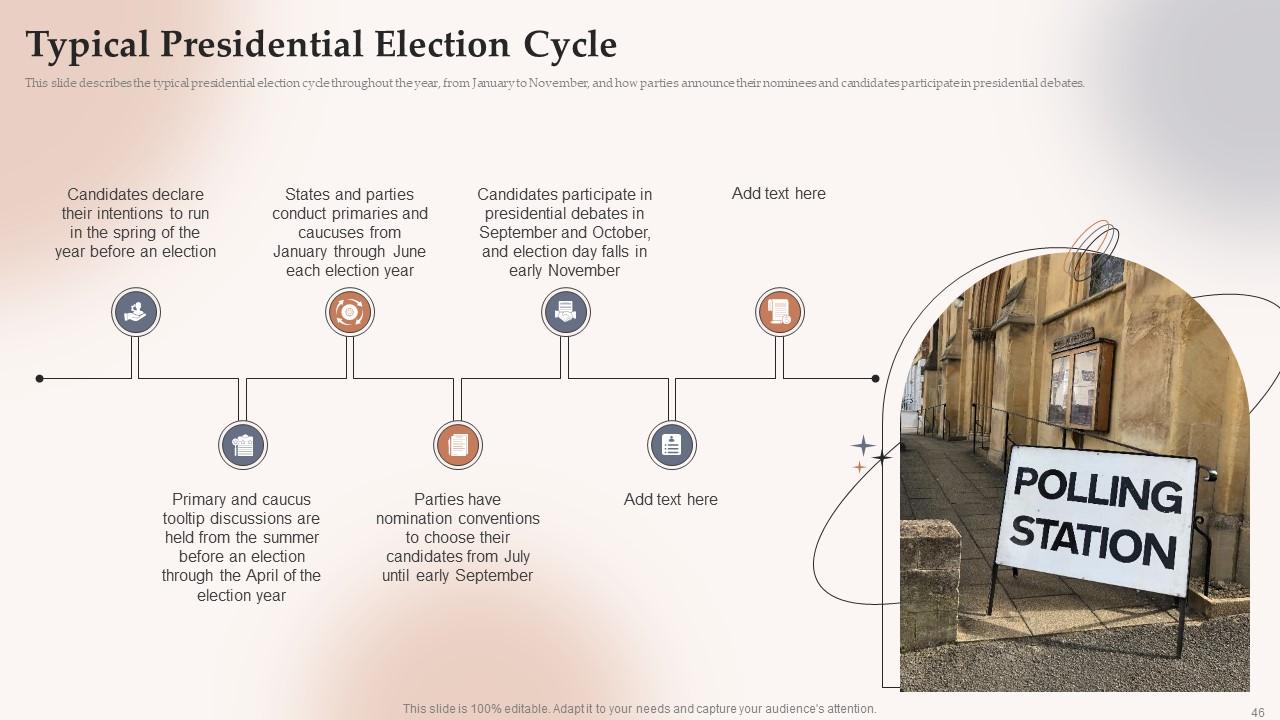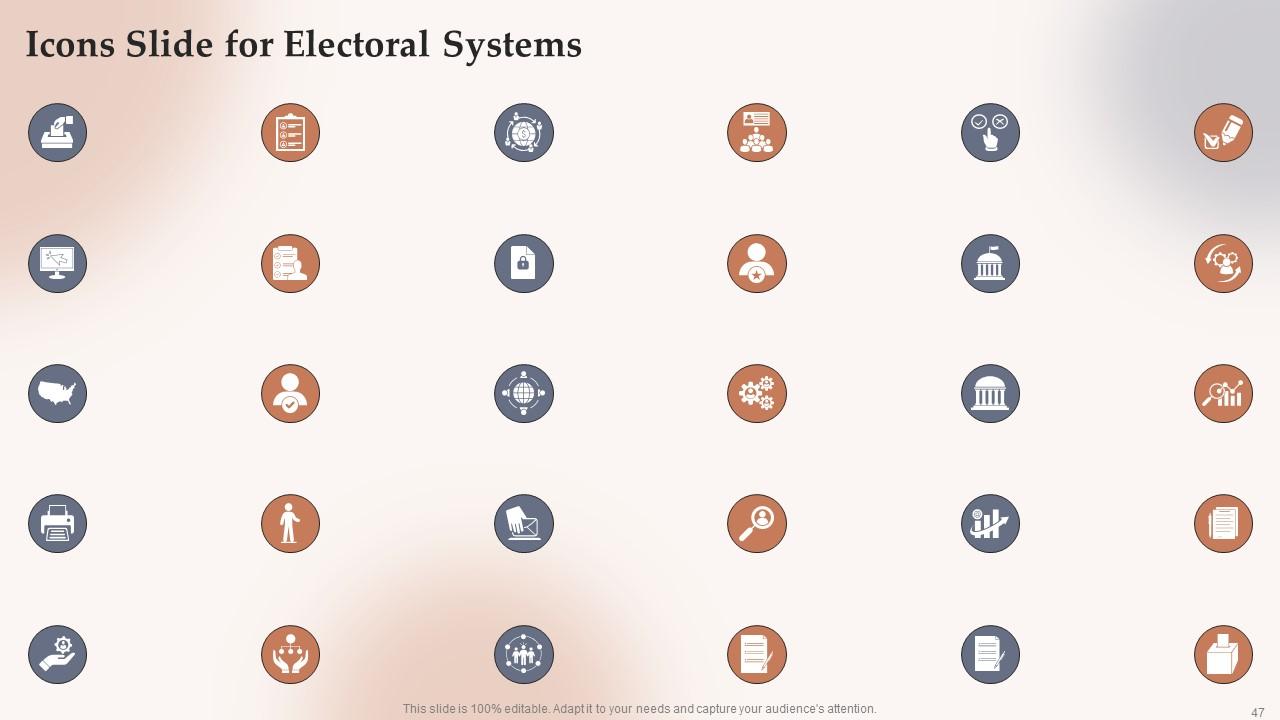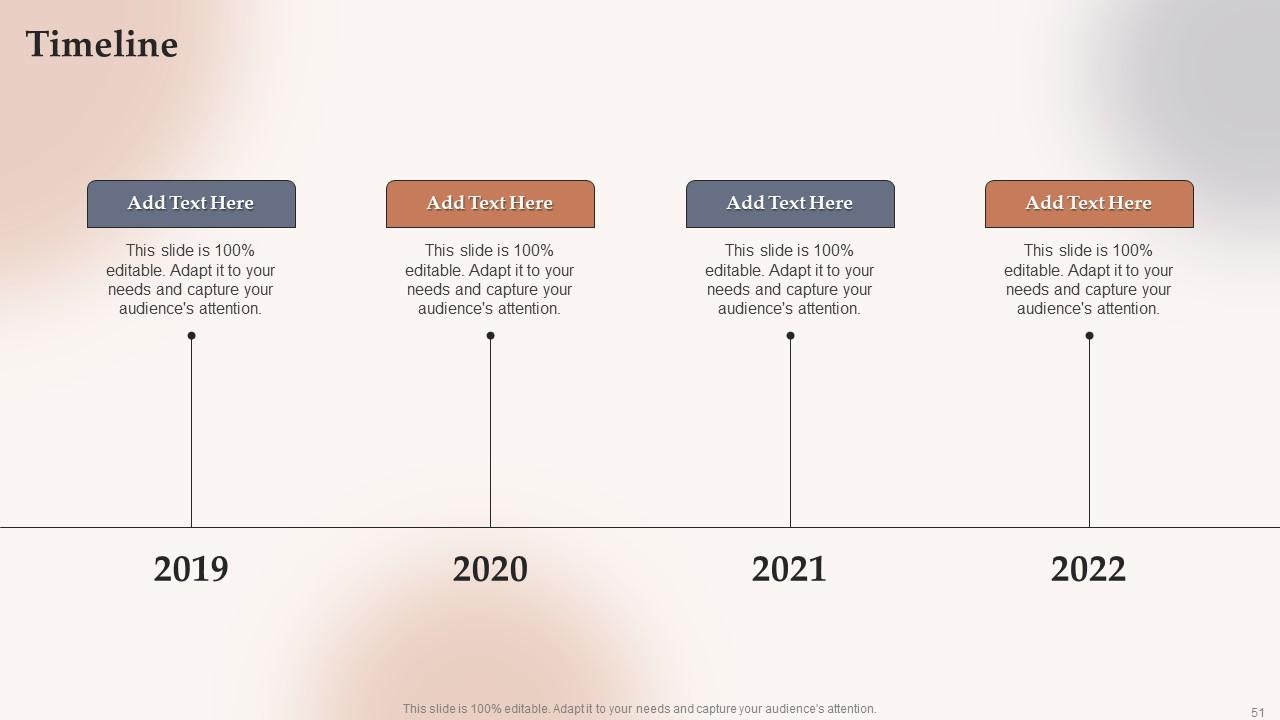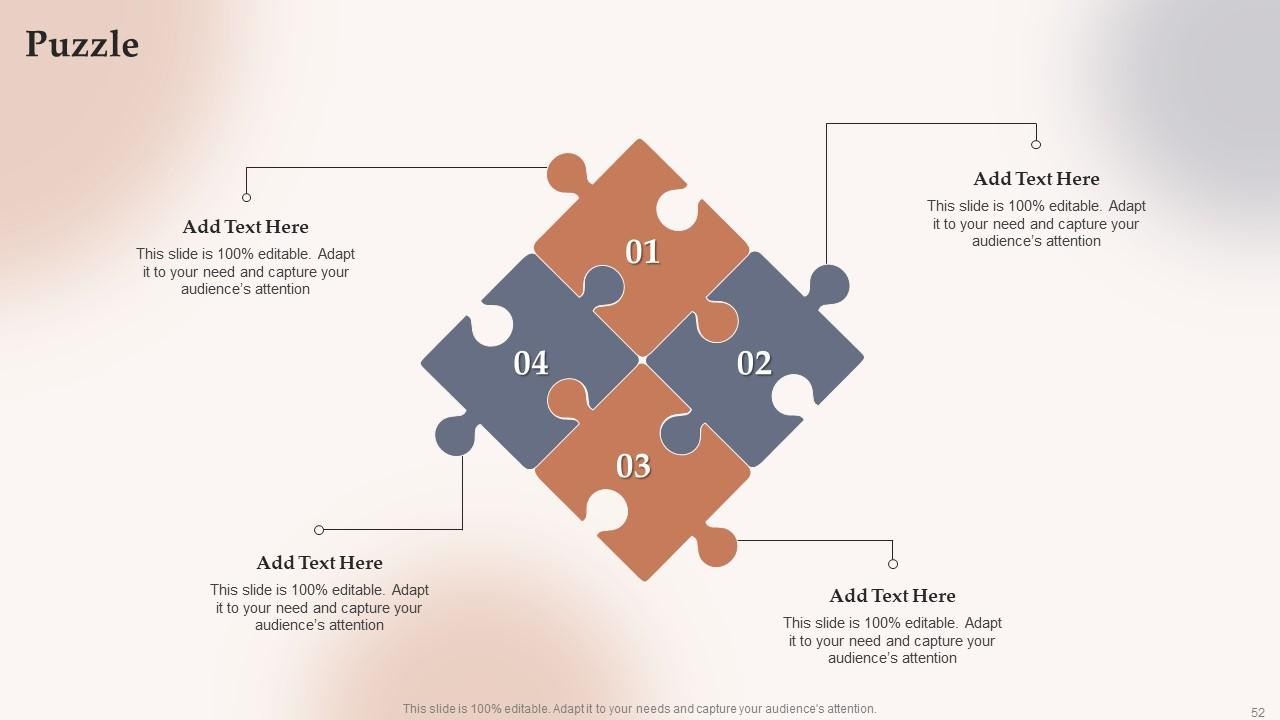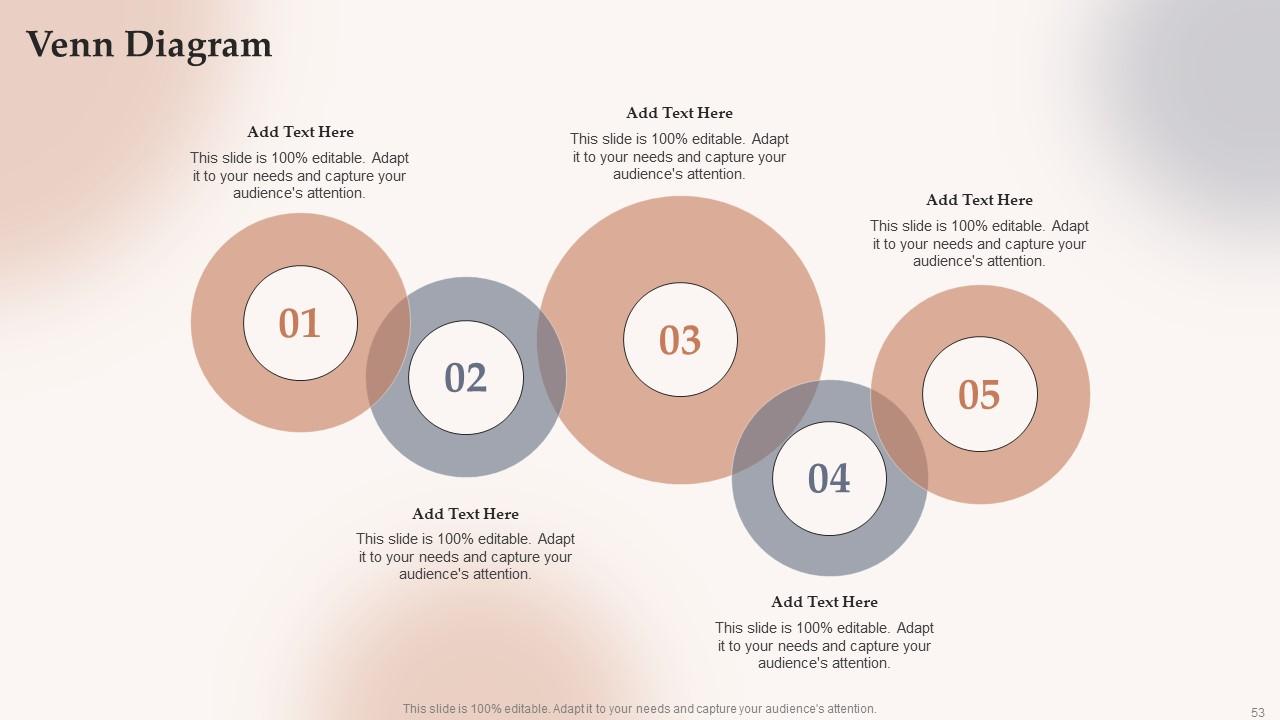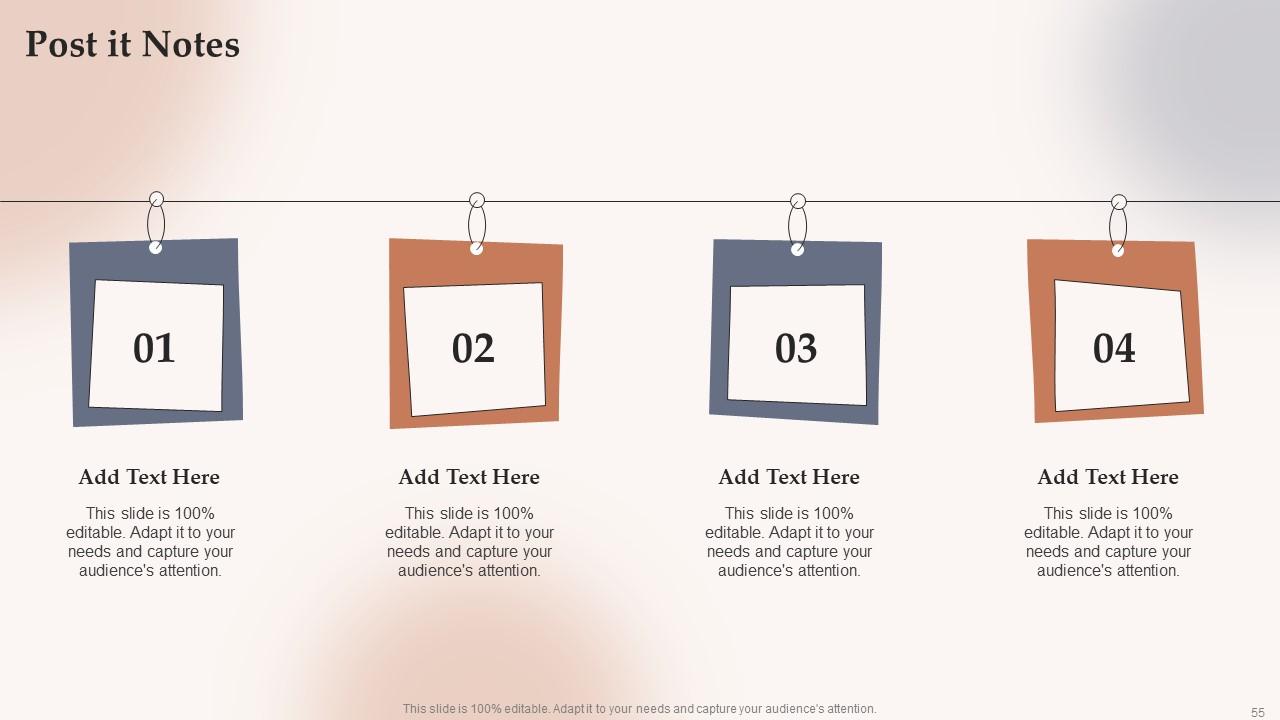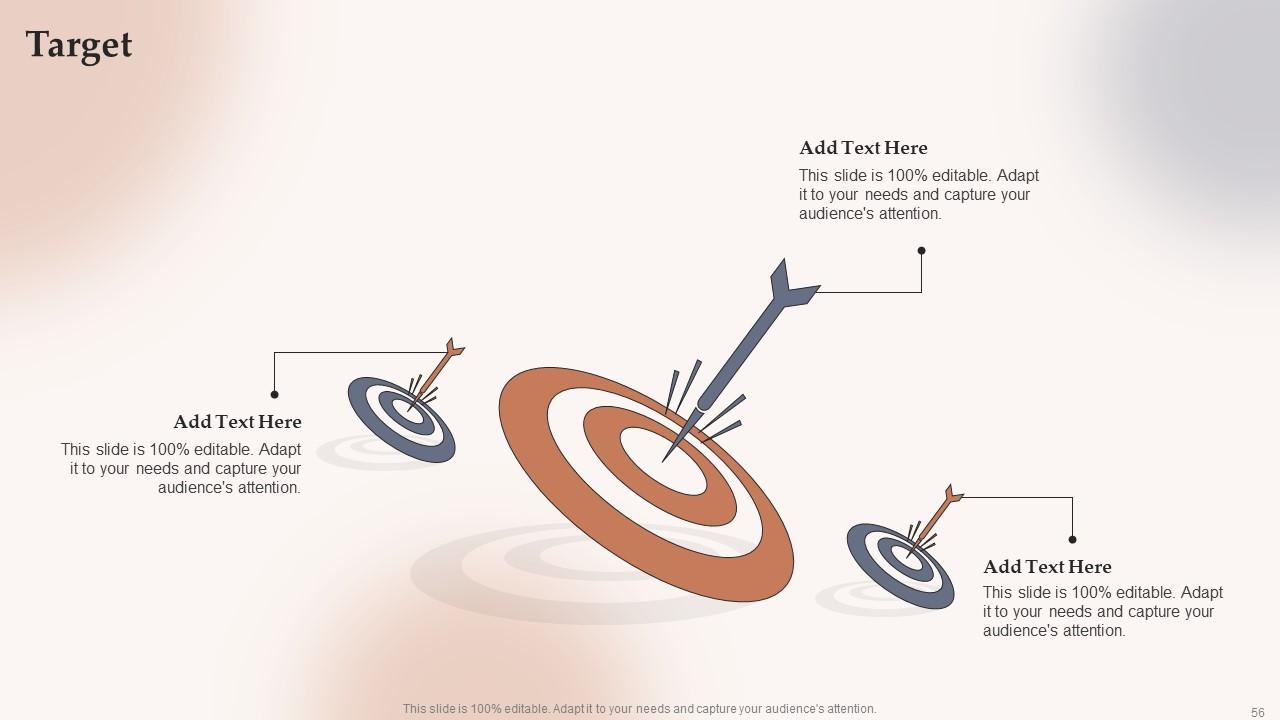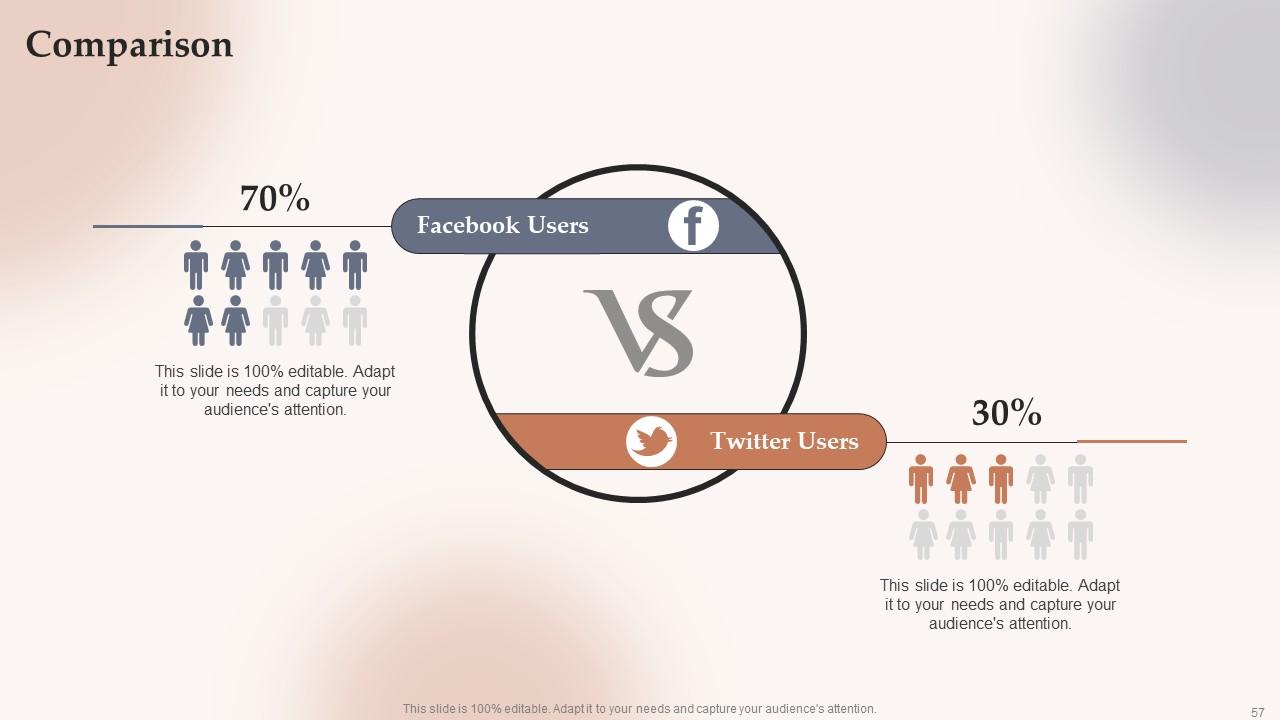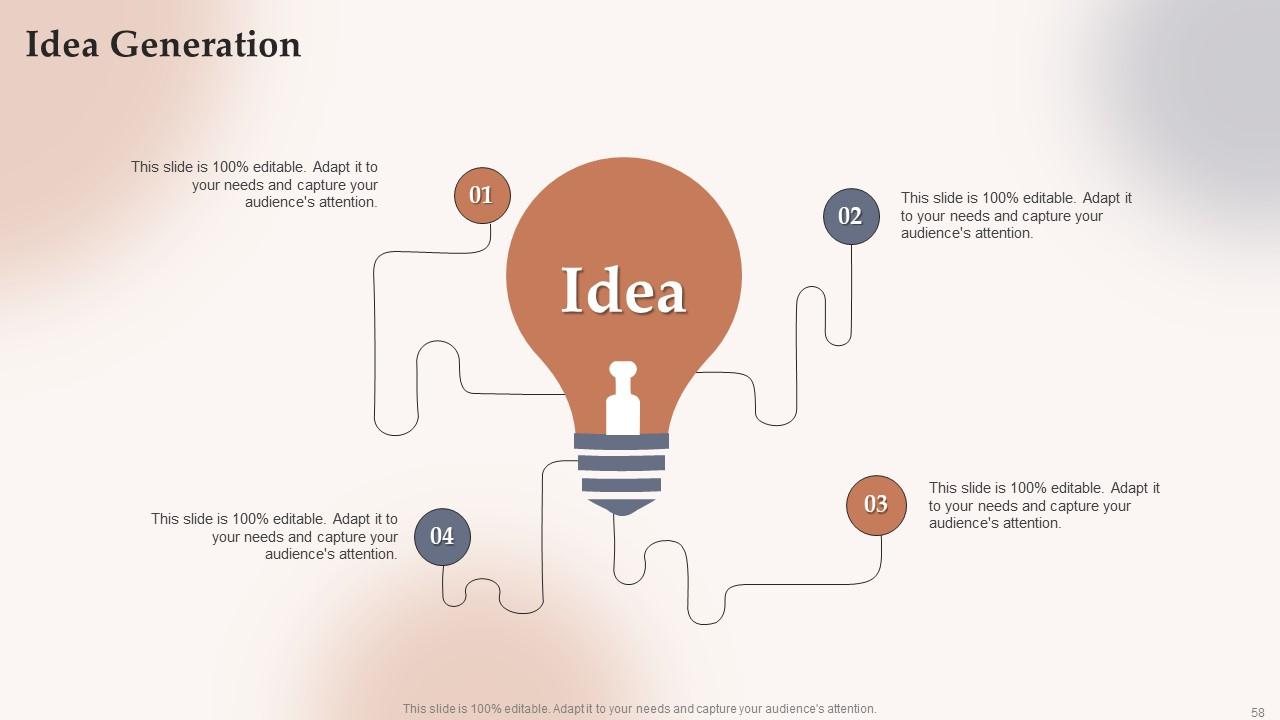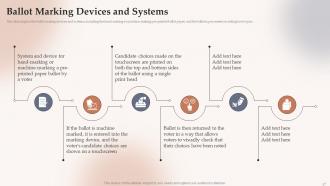Electoral Systems Powerpoint Presentation Slides
One of the most crucial institutional considerations for every democracy is the electoral system. The election system adopted has a significant impact on the countrys future political life. Here is an efficiently designed Electoral Systems template that gives a brief idea about the voting systems in the US, including voting system standards, testing, and certification. In this Voting Systems PowerPoint Presentation, we have covered various election types in the United States, the frequency of elections, and different ways to vote in elections. In addition, this Electoral Systems PPT contains the voting system types, types of voting equipment such as optical scan paper ballot systems, direct recording electronic, ballot marking devices and systems, etc. Also, the Voting Systems PPT presentation includes the complete voting process from candidate selection to election day in America. Furthermore, this Electoral Systems template comprises a presidential election process that provides for the electoral college, electors, working of electors, and typical presidential election cycle. Download this insightful voting systems template now.
One of the most crucial institutional considerations for every democracy is the electoral system. The election system adopt..
- Google Slides is a new FREE Presentation software from Google.
- All our content is 100% compatible with Google Slides.
- Just download our designs, and upload them to Google Slides and they will work automatically.
- Amaze your audience with SlideTeam and Google Slides.
-
Want Changes to This PPT Slide? Check out our Presentation Design Services
- WideScreen Aspect ratio is becoming a very popular format. When you download this product, the downloaded ZIP will contain this product in both standard and widescreen format.
-

- Some older products that we have may only be in standard format, but they can easily be converted to widescreen.
- To do this, please open the SlideTeam product in Powerpoint, and go to
- Design ( On the top bar) -> Page Setup -> and select "On-screen Show (16:9)” in the drop down for "Slides Sized for".
- The slide or theme will change to widescreen, and all graphics will adjust automatically. You can similarly convert our content to any other desired screen aspect ratio.
Compatible With Google Slides

Get This In WideScreen
You must be logged in to download this presentation.
PowerPoint presentation slides
Deliver an informational PPT on various topics by using this Electoral Systems Powerpoint Presentation Slides. This deck focuses and implements best industry practices, thus providing a birds-eye view of the topic. Encompassed with fifty nine slides, designed using high-quality visuals and graphics, this deck is a complete package to use and download. All the slides offered in this deck are subjective to innumerable alterations, thus making you a pro at delivering and educating. You can modify the color of the graphics, background, or anything else as per your needs and requirements. It suits every business vertical because of its adaptable layout.
People who downloaded this PowerPoint presentation also viewed the following :
Content of this Powerpoint Presentation
Slide 1: This slide introduces Electoral Systems. State your company name and begin.
Slide 2: This slide states Agenda of the presentation.
Slide 3: This slide presents Table of Content for the presentation.
Slide 4: This is another slide continuing Table of Content for the presentation.
Slide 5: This slide depicts title for one topic that is to be covered next in the template.
Slide 6: This slide depicts the overview of the voting system, which is a method to elect representatives for the people, etc.
Slide 7: This slide depicts title for three topics that are to be covered next in the template.
Slide 8: This slide represents the security standard of the voting system that ensures the security of voting machines.
Slide 9: This slide depicts the functionality standard of the voting system that ensures the correctness of all votes.
Slide 10: This slide represents the voting system standards such as privacy, usability, and accessibility that allow all voters.
Slide 11: This slide depicts title for one topic that is to be covered next in the template.
Slide 12: This slide represents the testing and certification of voting systems used by local governments.
Slide 13: This slide depicts title for four topics that are to be covered next in the template.
Slide 14: This slide represents the types of elections held in the US, including federal elections, state elections, municipal elections, etc.
Slide 15: This slide represents the other types of elections such as runoff elections, special elections, referendum elections, and recall elections.
Slide 16: This slide represents the frequency of elections in the united states, including general elections, presidential and congressional elections, etc.
Slide 17: This slide describes the different ways to vote in the US elections, such as absentee ballots, in-person voting, remote voting, and mail-in voting methods.
Slide 18: This slide depicts title for five topics that are to be covered next in the template.
Slide 19: This slide represents the first past the post type of voting system that was widely used in previous times, but now only a few countries use them.
Slide 20: This slide represents the features and effects of the first past the post-voting system, etc.
Slide 21: This slide describes the working of the first past the post voting system.
Slide 22: This slide depicts the counting of first past the post votes, including the total number of available seats.
Slide 23: This slide depicts the voting systems in the United States that include a two-round system, an instant-runoff voting system.
Slide 24: This slide depicts title for eight topics that are to be covered next in the template.
Slide 25: This slide represents the optical scan paper ballot systems that include paper ballots on which voters mark their choices through an oval shape, etc.
Slide 26: This slide shows the direct recording electronic voting system that includes three interfaces, such as a pushbutton, touchscreen, etc.
Slide 27: This slide depicts the ballot-making devices and systems, including the hand-making or machine-making pre-printed ballot paper, etc.
Slide 28: This slide describes the hybrid voting systems, including ImageCast Precinct optical scanner with ATI, ImageCast Evolution.
Slide 29: This slide represents the punch card voting system in which cards were used to make the voting selection by punching holes.
Slide 30: This slide represents the mechanical lever voting systems that are not in use since 2006, developed in the 1890s.
Slide 31: This slide represents the hand-counted paper ballots method of voting that includes the manual counting of paper ballots.
Slide 32: This slide depicts the electronic poll books that were used widely in the 2016 elections and were deployed in 36 states during 2018 in the United States.
Slide 33: This slide depicts title for eight topics that are to be covered next in the template.
Slide 34: This slide represents the electoral process in the US, including candidate selection, qualifications, the nominating process, etc.
Slide 35: This slide describes the candidate selection process of the electoral system in the US that includes two parties.
Slide 36: This slide depicts the eligibility criteria to run for public offices such as the United States House of Representatives, United States Senate, etc.
Slide 37: This slide represents the nominating procedures in the US that cover the caucus party, sending delegates, etc.
Slide 38: This slide depicts the qualifications for voting that covers the state's residency for a specific number of years, read and write ability, etc.
Slide 39: This slide represents the registering process of voters, including through mails, forms from a local registrar, in-person visits to the office, etc.
Slide 40: This slide illustrates the voting districts, including precints in which each state, city, country, or ward is divided, etc.
Slide 41: This slide represents the election day, votes can be made through ballot papers or voting machines in a private voting booth.
Slide 42: This slide depicts title for four topics that are to be covered next in the template.
Slide 43: This slide depicts the presidential election process that is performed through electoral college procedure.
Slide 44: This slide represents the process of selecting electors in different states of the US, and it includes who is chosen, how they are chosen, etc.
Slide 45: This slide represents the working of the electoral college process in the United States, including how votes for president are tallied in 48 states.
Slide 46: This slide describes the typical presidential election cycle throughout the year, from January to November, etc.
Slide 47: This slide contains all the icons used in this presentation.
Slide 48: This slide is titled as Additional Slides for moving forward.
Slide 49: This is Our Mission slide with related imagery and text.
Slide 50: This is Our Team slide with names and designation.
Slide 51: This is a Timeline slide. Show data related to time intervals here.
Slide 52: This slide contains Puzzle with related icons and text.
Slide 53: This slide depicts Venn diagram with text boxes.
Slide 54: This slide provides 30 60 90 Days Plan with text boxes.
Slide 55: This slide shows Post It Notes. Post your important notes here.
Slide 56: This is Our Target slide. State your targets here.
Slide 57: This is a Comparison slide to state comparison between commodities, entities etc.
Slide 58: This is an Idea Generation slide to state a new idea or highlight information, specifications etc.
Slide 59: This is a Thank You slide with address, contact numbers and email address.
Electoral Systems Powerpoint Presentation Slides with all 64 slides:
Use our Electoral Systems Powerpoint Presentation Slides to effectively help you save your valuable time. They are readymade to fit into any presentation structure.
FAQs
A voting system is a method of electing representatives for the people. Its purpose is to ensure that every vote counts and that the outcome of the election is fair and representative of the people's choices.
The security standards of the voting system ensure the security of voting machines to prevent tampering, hacking, or any other form of interference with the election process.
The types of elections held in the US include federal, state, municipal, runoff, special, referendum, and recall elections.
The first past the post voting system is a system where the candidate with the most votes wins the election. It is used in only a few countries today.
The voting systems used in the US include optical scan paper ballot systems, direct recording electronic voting systems, punch card voting systems, mechanical lever voting systems, hand-counted paper ballots, and electronic poll books.
-
Satisfied with the way SlideTeam resolved my query regarding the right business PPTs that I was having difficulty finding. I found the perfect match with their assistance.
-
Unique research projects to present in meeting.


